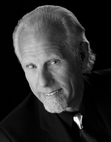Paul Bishop's Blog, page 10
August 21, 2019
THE CARTER COLLECTION
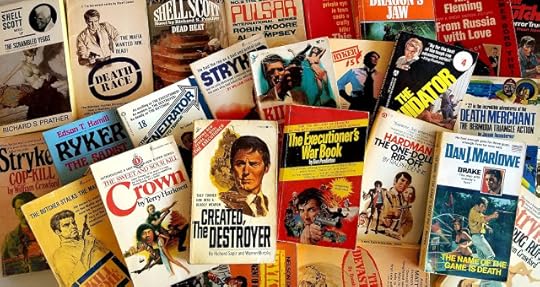 THE CARTER COLLECTIONFacebook social groups are a common ground in cyberspace where like-minded individuals can interact, exchange views, and share their knowledge of whatever broad subject or niche interest to which the group is dedicated. From apple bobbing to zydeco music, no matter how obscure or how small the circle of dedicated enthusiasts, every hobby, activity, or creative endeavor imaginable has a Facebook group to represent it. These groups can be very active or stagnating in a black hole. Some are all hearts and rainbows (very, very few) while others can be a hotbed of arguments, bullying, name calling, and inflammatory discourse (more common). This is often determined by the group moderator’s level of control, oversight and tolerance for bad behavior. Most groups fall into a comfortable middle ground between the two extremes.
THE CARTER COLLECTIONFacebook social groups are a common ground in cyberspace where like-minded individuals can interact, exchange views, and share their knowledge of whatever broad subject or niche interest to which the group is dedicated. From apple bobbing to zydeco music, no matter how obscure or how small the circle of dedicated enthusiasts, every hobby, activity, or creative endeavor imaginable has a Facebook group to represent it. These groups can be very active or stagnating in a black hole. Some are all hearts and rainbows (very, very few) while others can be a hotbed of arguments, bullying, name calling, and inflammatory discourse (more common). This is often determined by the group moderator’s level of control, oversight and tolerance for bad behavior. Most groups fall into a comfortable middle ground between the two extremes. If an interest is broad enough there can be hundreds of Facebook groups in which to participate. Even if a subject appeals to only an infinitesimal sampling of Internet surfers, it is bound to have a handful of representative groups, each with its own flavor, personality, perspective, or approach to the given subject. Many times connected or similar groups are splintered off from an original group due to a clash of egos, arguments, or other derisive factors. Participants often join numerous groups involving the same subject looking for varied input or searching for the virtual hangout which best suits their needs.
If an interest is broad enough there can be hundreds of Facebook groups in which to participate. Even if a subject appeals to only an infinitesimal sampling of Internet surfers, it is bound to have a handful of representative groups, each with its own flavor, personality, perspective, or approach to the given subject. Many times connected or similar groups are splintered off from an original group due to a clash of egos, arguments, or other derisive factors. Participants often join numerous groups involving the same subject looking for varied input or searching for the virtual hangout which best suits their needs.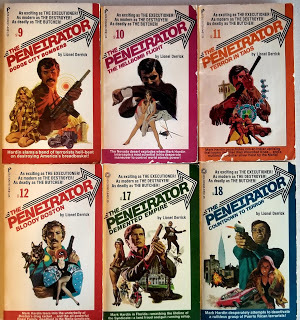 The Men's Adventure Paperback Series of the '70s & '80s (now Men's Adventure Paperbacks of the 20th Century) is a hangout for fans of old school action fiction series such as The Executioner, The Destroyer, The Death Merchant, The Penetrator, and a horde of similar vigilante avengers, mercenaries, rogue cops, secret agents, and others who always have time between murders, mayhem, and gun porn to bed down a bevy of long-legged, buxom, often traitorous vixens, and do it all in under 200 pages. This is an amazing feat when you consider it takes modern action heroes—such as Jack Reacher or Mitch Rapp—600 to 800 pages to save the world.
The Men's Adventure Paperback Series of the '70s & '80s (now Men's Adventure Paperbacks of the 20th Century) is a hangout for fans of old school action fiction series such as The Executioner, The Destroyer, The Death Merchant, The Penetrator, and a horde of similar vigilante avengers, mercenaries, rogue cops, secret agents, and others who always have time between murders, mayhem, and gun porn to bed down a bevy of long-legged, buxom, often traitorous vixens, and do it all in under 200 pages. This is an amazing feat when you consider it takes modern action heroes—such as Jack Reacher or Mitch Rapp—600 to 800 pages to save the world.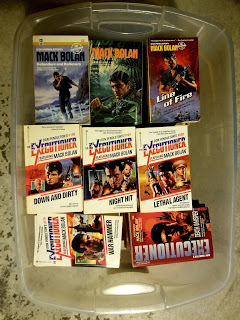 To the uninitiated, men’s adventure paperbacks would appeared to be a micro-niche interest—even when compared to apple-bobbing or Zydeco music. In reality, however, the Men's Adventure Paperback Series group boasts close to 5,000 members. Around a hundred members participate occasionally, while between twenty and fifty hardcore members participate weekly or daily. There are also a number of lurkers who sporadically pop up to voice an opinion, share photos of paperback finds, or ask a question.
To the uninitiated, men’s adventure paperbacks would appeared to be a micro-niche interest—even when compared to apple-bobbing or Zydeco music. In reality, however, the Men's Adventure Paperback Series group boasts close to 5,000 members. Around a hundred members participate occasionally, while between twenty and fifty hardcore members participate weekly or daily. There are also a number of lurkers who sporadically pop up to voice an opinion, share photos of paperback finds, or ask a question.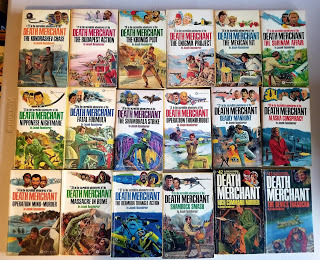 Created in 2009, it's an active group comprised almost exclusively of men of a certain age who read uncountable examples of men’s trash fiction in their misspent youth. All are readers. Many are writers—some even contributing to the series back in the day, and others who have become writers for whom these series were cherished inspirations. The members are incredibly knowledgeable about their collective interest.
Created in 2009, it's an active group comprised almost exclusively of men of a certain age who read uncountable examples of men’s trash fiction in their misspent youth. All are readers. Many are writers—some even contributing to the series back in the day, and others who have become writers for whom these series were cherished inspirations. The members are incredibly knowledgeable about their collective interest. 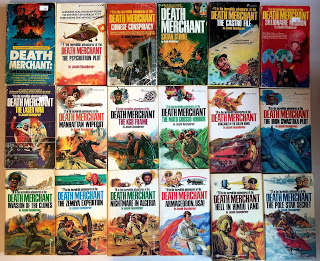 There is not a men’s adventure paperback ever written not read by at least one member in the group. In my eight years of participation, there has never been a question asked about men’s adventure paperbacks that hasn’t been answered with astonishing speed by another group member.
There is not a men’s adventure paperback ever written not read by at least one member in the group. In my eight years of participation, there has never been a question asked about men’s adventure paperbacks that hasn’t been answered with astonishing speed by another group member. 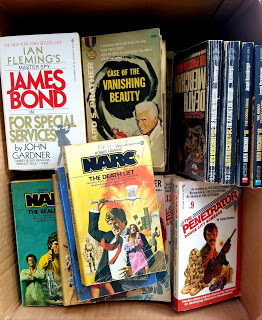 Even the most obscure memory of a series—it had a blue cover and a guy with a big-ass knife who worked for some kind of secret organization—generates the name of the series (The Mesmerizer), further detailed information (Three books in the series...Written by Butch Randy...Which was a pseudonym for current bestselling author XYZ), and very often a cover scan.
Even the most obscure memory of a series—it had a blue cover and a guy with a big-ass knife who worked for some kind of secret organization—generates the name of the series (The Mesmerizer), further detailed information (Three books in the series...Written by Butch Randy...Which was a pseudonym for current bestselling author XYZ), and very often a cover scan. 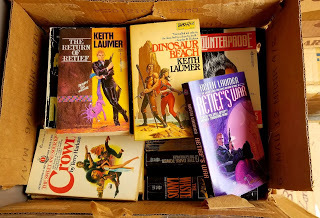 On top of everything else, members of the Men's Adventure Paperback Series group are frankly the kindest, most polite, and generous folks anywhere on social media. No drama—ever. The few trolls who have popped up have been handled with the speed and efficiency of a champion Whack-A-Mole player. The group is a haven of sanity for many members who participate nowhere else on social media.
On top of everything else, members of the Men's Adventure Paperback Series group are frankly the kindest, most polite, and generous folks anywhere on social media. No drama—ever. The few trolls who have popped up have been handled with the speed and efficiency of a champion Whack-A-Mole player. The group is a haven of sanity for many members who participate nowhere else on social media.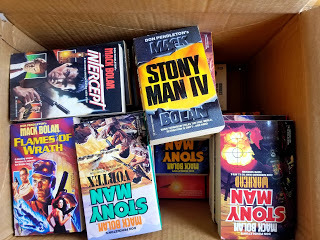 Group activity is also not confined to Facebook and the Internet. Many round-robin boxes have traveled around the country to land at the home of participating members. The member who starts the round-robin puts twenty men’s adventure related paperbacks into a box and mails it to the next member on the sign-up list.
Group activity is also not confined to Facebook and the Internet. Many round-robin boxes have traveled around the country to land at the home of participating members. The member who starts the round-robin puts twenty men’s adventure related paperbacks into a box and mails it to the next member on the sign-up list.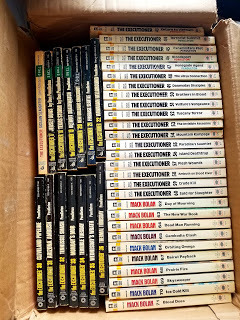 When the next participating member receives the box, they take out the books they want and replace them with an equal number of books from their own collection and send it on to the next participant. There are usually ten to as many as thirty group members participating, so the box can take a while to make it back to the originating member. However, when it does, it is rare for there to be any of the original books inside.
When the next participating member receives the box, they take out the books they want and replace them with an equal number of books from their own collection and send it on to the next participant. There are usually ten to as many as thirty group members participating, so the box can take a while to make it back to the originating member. However, when it does, it is rare for there to be any of the original books inside.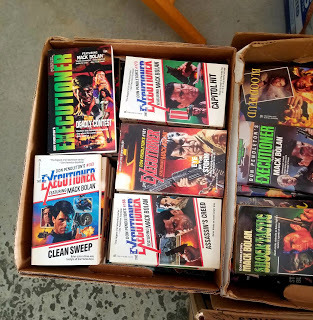 Summer usually involves a paperback swap. Participating members send a vintage men’s adventure paperback to another participant, while another participant sends them a vintage men’s adventure paperback. The swaps are shown on the group page with reviews of the received books. It’s an activity that keeps the group’s Facebook page alive with comments and interesting threads.
Summer usually involves a paperback swap. Participating members send a vintage men’s adventure paperback to another participant, while another participant sends them a vintage men’s adventure paperback. The swaps are shown on the group page with reviews of the received books. It’s an activity that keeps the group’s Facebook page alive with comments and interesting threads.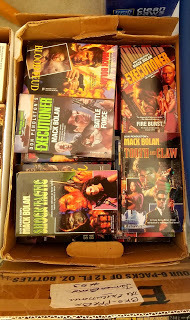 Naturally, during the winter holidays, members of the men’s adventure paperback group are obviously too macho to participate in a Secret Santa anonymous exchange of several vintage paperbacks. However, by switching the name to Vigilante Santa an activity similar to Secret Santa (actually, it’s exactly the same) has proven to be a successful yearly event.
Naturally, during the winter holidays, members of the men’s adventure paperback group are obviously too macho to participate in a Secret Santa anonymous exchange of several vintage paperbacks. However, by switching the name to Vigilante Santa an activity similar to Secret Santa (actually, it’s exactly the same) has proven to be a successful yearly event.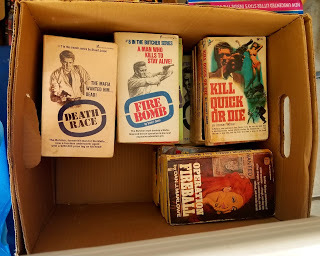 About six or seven months ago, a woman named Allysa Rivers contacted another of our Men's Adventure group moderators, Tom Simon, via the group's Facebook page. She wanted to know what to do with her late brother's Executioner books as she had a ton of them. If she couldn't find a home for them she was going to either take them to Goodwill or toss them. She told Tom she lived in Ventura, California. Tom immediately passed her info on to me since he knew I lived about 15 minutes south of Ventura.
About six or seven months ago, a woman named Allysa Rivers contacted another of our Men's Adventure group moderators, Tom Simon, via the group's Facebook page. She wanted to know what to do with her late brother's Executioner books as she had a ton of them. If she couldn't find a home for them she was going to either take them to Goodwill or toss them. She told Tom she lived in Ventura, California. Tom immediately passed her info on to me since he knew I lived about 15 minutes south of Ventura.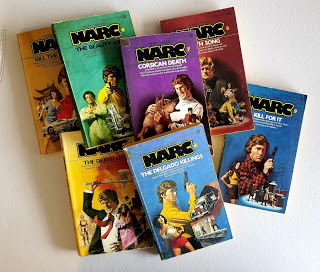 I reached out to Allysa and offered to take a look at the collection and advise her. She said she'd contact me after she had gone through the books and organize them. That odd comment—I say odd because why do you need to organize a couple of boxes of batter Executioner paperbacks—ended our conversation and I thought no more about it.
I reached out to Allysa and offered to take a look at the collection and advise her. She said she'd contact me after she had gone through the books and organize them. That odd comment—I say odd because why do you need to organize a couple of boxes of batter Executioner paperbacks—ended our conversation and I thought no more about it.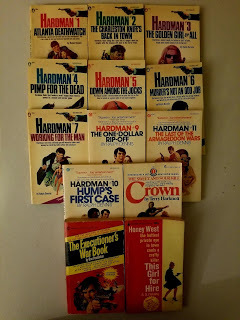 However, out of the blue at the beginning of May, 2019, I received a Facebook message from Allysa. She said she had finally organized her brother's books and asked if I would advise her about what to do with them. I had an appointment near her house the following day, so we arranged to meet.
However, out of the blue at the beginning of May, 2019, I received a Facebook message from Allysa. She said she had finally organized her brother's books and asked if I would advise her about what to do with them. I had an appointment near her house the following day, so we arranged to meet.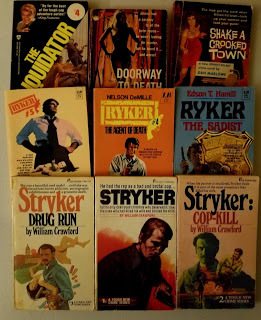 When I arrived, Allysa took me into her garage. I immediately became weak in the knees and almost began to hyperventilate. This collection was not a couple of boxes of battered paperbacks from the Executioner series as I expected. Instead there were boxes and boxes and boxes filled with a wide array of men's adventure paperbacks in what appeared to be excellent condition.
When I arrived, Allysa took me into her garage. I immediately became weak in the knees and almost began to hyperventilate. This collection was not a couple of boxes of battered paperbacks from the Executioner series as I expected. Instead there were boxes and boxes and boxes filled with a wide array of men's adventure paperbacks in what appeared to be excellent condition.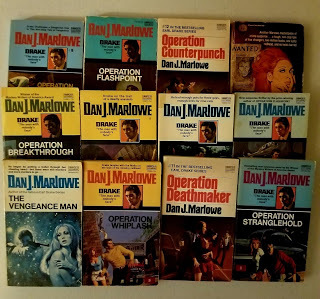 Digging randomly through the first few boxes, I ran my hands over full runs of some of the most highly sought after, hard to impossible to find, high value men's adventure series with brightly colored pristine covers, many of which had never been opened—Black Samurai, Narc, The Liquidator, Riker, Stryker, Dark Angel (four books worth upward if $1000 if they could ever be found, especially the elusive, low print run fourth book), and long runs of many other classic and iconic men's adventure series. I had walked into Aladdin's cave, a once in a lifetime golden motherlode.
Digging randomly through the first few boxes, I ran my hands over full runs of some of the most highly sought after, hard to impossible to find, high value men's adventure series with brightly colored pristine covers, many of which had never been opened—Black Samurai, Narc, The Liquidator, Riker, Stryker, Dark Angel (four books worth upward if $1000 if they could ever be found, especially the elusive, low print run fourth book), and long runs of many other classic and iconic men's adventure series. I had walked into Aladdin's cave, a once in a lifetime golden motherlode.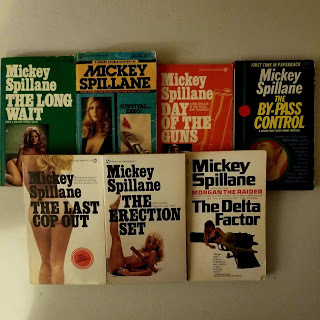 When I could breathe again, I tried to keep my voice from sounding shaky and responsibly explained the books would bring in a sizable amount of cash via eBay if she could be patient until a hungry collector with a fat wallet came along. I was quite shocked when Allysa said she wasn't concerned about the money. She simply wanted her brother's books to go to a good home.
When I could breathe again, I tried to keep my voice from sounding shaky and responsibly explained the books would bring in a sizable amount of cash via eBay if she could be patient until a hungry collector with a fat wallet came along. I was quite shocked when Allysa said she wasn't concerned about the money. She simply wanted her brother's books to go to a good home.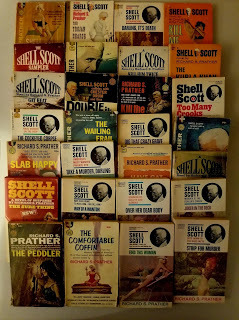 I told her I could share some with our men’s adventure group made up of readers who cherish these types of books. I could also send some via Operation Paperback to our military overseas, and take the rest to the VA hospital where men's adventure type books are craved by the patients there. Allysa was delighted with the plan, but she needed the books gone from her garage as quickly as possible as she was moving. She said if I took them right then, I could have them gratis, no money, zip, nada, zero down, zero at signing, and zero payments.
I told her I could share some with our men’s adventure group made up of readers who cherish these types of books. I could also send some via Operation Paperback to our military overseas, and take the rest to the VA hospital where men's adventure type books are craved by the patients there. Allysa was delighted with the plan, but she needed the books gone from her garage as quickly as possible as she was moving. She said if I took them right then, I could have them gratis, no money, zip, nada, zero down, zero at signing, and zero payments.  I started loading up the boxes and they just kept coming—A full run of The Executioner and the Stoney Man series (through 2010) in VG condition. A full run of The Destroyer series in unopened mint condition. Near full runs of The Penetrator, Richard Blayde, The Butcher, and The Death Merchant. Boxes with The Dark Angel, Crown, Honey West, the Drake series by Stephen Marlowe, a ton of Shell Scott books by Richard Prather, and partial odds and ends from a bunch of other series. She then asked me if I wanted the three boxes of Westerns with nearly full runs of Longarm, Lone Star, and other Western series. I damn near wept...
I started loading up the boxes and they just kept coming—A full run of The Executioner and the Stoney Man series (through 2010) in VG condition. A full run of The Destroyer series in unopened mint condition. Near full runs of The Penetrator, Richard Blayde, The Butcher, and The Death Merchant. Boxes with The Dark Angel, Crown, Honey West, the Drake series by Stephen Marlowe, a ton of Shell Scott books by Richard Prather, and partial odds and ends from a bunch of other series. She then asked me if I wanted the three boxes of Westerns with nearly full runs of Longarm, Lone Star, and other Western series. I damn near wept...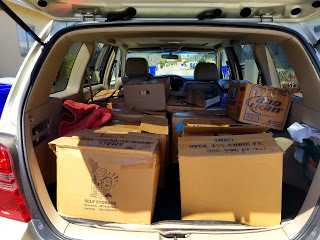 But she wasn't done. Once I loaded the Westerns, she told me her sister and mother had collected vintage sci-fi paperbacks, about double the number of her brother's men's adventure collection. She wondered if, after she had gone through them all, would I come back and take them...again for free (this would involve another trip and double the amount of boxes involved in the first pick up). By now I was beside myself with shock over the treasure trove.
But she wasn't done. Once I loaded the Westerns, she told me her sister and mother had collected vintage sci-fi paperbacks, about double the number of her brother's men's adventure collection. She wondered if, after she had gone through them all, would I come back and take them...again for free (this would involve another trip and double the amount of boxes involved in the first pick up). By now I was beside myself with shock over the treasure trove.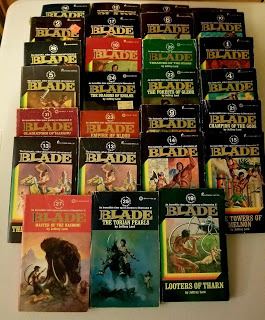 I asked Allysa about her brother and how he came to collect the books. She told me his name was Mike Carter. He lived in Cheyenne, Wyoming, where he and Allysa grew up. He was a big supporter of the military having been in both the Army and the Air Force for different periods of time. Mike made a living driving a Yellow Cab taxi in Cheyenne, and loved to read whenever he had a spare moment. His taxi always had a selection of men’s adventure books scattered across the front passenger seat. Inside the front covers of his books Mike would use his taxi stamp as an identifying bookplate:
I asked Allysa about her brother and how he came to collect the books. She told me his name was Mike Carter. He lived in Cheyenne, Wyoming, where he and Allysa grew up. He was a big supporter of the military having been in both the Army and the Air Force for different periods of time. Mike made a living driving a Yellow Cab taxi in Cheyenne, and loved to read whenever he had a spare moment. His taxi always had a selection of men’s adventure books scattered across the front passenger seat. Inside the front covers of his books Mike would use his taxi stamp as an identifying bookplate: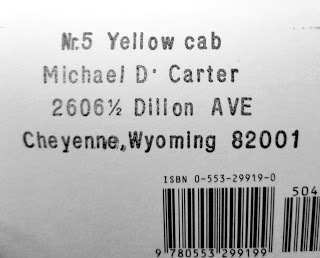 Nr. 5 Yellow cab
Nr. 5 Yellow cabMichael D. Carter
2606 ½ Dillon Ave
Cheyenne, Wyoming 82011
Mike had a collector’s personality, buying books in the different men’s adventure series he was passionate about even if he didn’t have time to read them. They filled the shelves in his apartment. He never married and was happiest when surrounded by books. Unfortunately, Mike suffered from numerous health issues and passed away at the early age of 58.
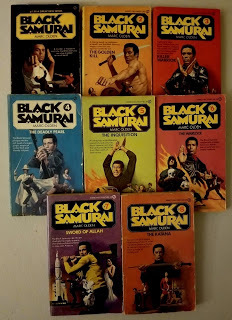 Finding Mike’s books was the kind of time capsule every book hound dreams of stumbling into. It was the perfect storm of hard to find series in fantastic condition overall, and at the perfect price—free. Like Mike, I am passionate about this genre of books, and was thrilled to simply hold in my hands the many amazing gems in his collection. In reality, the monetary value of the collection in the grand scheme was relatively innocuous, but the intrinsic value to collectors was over the moon.
Finding Mike’s books was the kind of time capsule every book hound dreams of stumbling into. It was the perfect storm of hard to find series in fantastic condition overall, and at the perfect price—free. Like Mike, I am passionate about this genre of books, and was thrilled to simply hold in my hands the many amazing gems in his collection. In reality, the monetary value of the collection in the grand scheme was relatively innocuous, but the intrinsic value to collectors was over the moon. 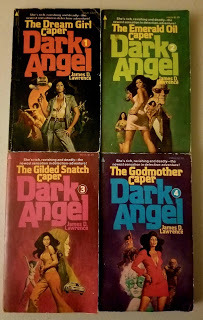 The whole experience was a freakish windfall, which I felt the need to pay forward. I felt a responsibility to do for Mike’s collection what I would like done with mine someday—having the books passed on to somebody who will understand the joy reading them brought me. There were books in the collection I hadn't seen in the wild in 30 or more years—paperbacks so scarce, especially in full runs in amazing condition, as to be virtually impossible to find on the collectors market.
The whole experience was a freakish windfall, which I felt the need to pay forward. I felt a responsibility to do for Mike’s collection what I would like done with mine someday—having the books passed on to somebody who will understand the joy reading them brought me. There were books in the collection I hadn't seen in the wild in 30 or more years—paperbacks so scarce, especially in full runs in amazing condition, as to be virtually impossible to find on the collectors market.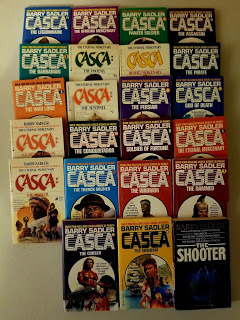 While it is true they would turn a decent profit in eBay auctions, but I'm strictly a collector, not a dealer. I also felt the same way as Allysa—dispensing of the collection was not about profit. Nor was it about hording the books for myself. It was about honoring Mike Carter and his collection by giving access to the books to other like-minded enthusiasts. I felt this strange kinship to Mike Carter and I was determined to find homes for the books with collectors who would appreciate and value them for what they are, as opposed to their market value.
While it is true they would turn a decent profit in eBay auctions, but I'm strictly a collector, not a dealer. I also felt the same way as Allysa—dispensing of the collection was not about profit. Nor was it about hording the books for myself. It was about honoring Mike Carter and his collection by giving access to the books to other like-minded enthusiasts. I felt this strange kinship to Mike Carter and I was determined to find homes for the books with collectors who would appreciate and value them for what they are, as opposed to their market value.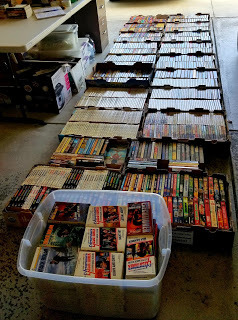 In the weeks after taking possession of Mike’s collection, I dug through the books trying to determine how best to disperse them. There were books from both ends of the collecting spectrum. Many were not collectibles, but were still in great condition and still worth being read. Those books were donated through various charitable venues.
In the weeks after taking possession of Mike’s collection, I dug through the books trying to determine how best to disperse them. There were books from both ends of the collecting spectrum. Many were not collectibles, but were still in great condition and still worth being read. Those books were donated through various charitable venues.  Some were boxed and sending to our military overseas through Operation Paperback. Others were taken to the local VA hospital. Two boxes of fantasy novels went to a women's shelter, who were delighted to take them. A judicious selection was taken to the new, under stocked, high school library at a local juvenile detention center.
Some were boxed and sending to our military overseas through Operation Paperback. Others were taken to the local VA hospital. Two boxes of fantasy novels went to a women's shelter, who were delighted to take them. A judicious selection was taken to the new, under stocked, high school library at a local juvenile detention center.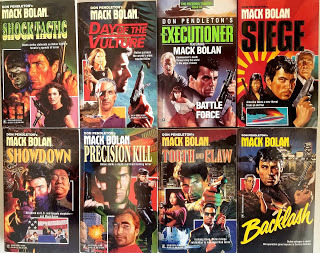 The great majority of the books, however, were photographed and posted to the Men’s Adventure Paperbacks group on Facebook. The deal was first come first serve, with resellers being blocked out. Whoever claimed the books first (in the beginning no more than ten per person) could have them for the cost of postage. No matter what the intrinsic value was of a book, it was not sold. It was given. A gift from Mike Carter to another fan of the genre.
The great majority of the books, however, were photographed and posted to the Men’s Adventure Paperbacks group on Facebook. The deal was first come first serve, with resellers being blocked out. Whoever claimed the books first (in the beginning no more than ten per person) could have them for the cost of postage. No matter what the intrinsic value was of a book, it was not sold. It was given. A gift from Mike Carter to another fan of the genre.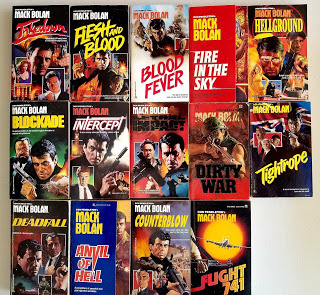 Dispersing the books in this manner took almost three months and involved a lot of shipping and handling. It also involved many trips to the Post Office, where the desk clerks would shake their heads when they same me come in with another tower of packages. In all over 3,000 books were sent to collectors and readers in 38 different states and three different countries.
Dispersing the books in this manner took almost three months and involved a lot of shipping and handling. It also involved many trips to the Post Office, where the desk clerks would shake their heads when they same me come in with another tower of packages. In all over 3,000 books were sent to collectors and readers in 38 different states and three different countries. Despite the time involved, I had a blast doing this. It's much more fun playing a men's adventure version of Santa Claus than trying to Scrooge a few bucks from eBay that are going to make no difference to me in the long run.
Despite the time involved, I had a blast doing this. It's much more fun playing a men's adventure version of Santa Claus than trying to Scrooge a few bucks from eBay that are going to make no difference to me in the long run. 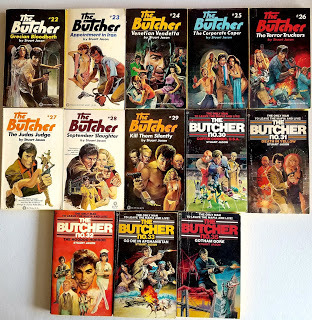 Trying to handle the opportunity in an altruistic way has provide me with good feelings and memories for a long time. I hope Mike Carter was looking down the entire time this went on and was smiling, knowing how much pleasure his books were bringing to so many others—especially me.
Trying to handle the opportunity in an altruistic way has provide me with good feelings and memories for a long time. I hope Mike Carter was looking down the entire time this went on and was smiling, knowing how much pleasure his books were bringing to so many others—especially me.Thanks, Mike...I hope you are in a heaven surrounded by all the books you loved so much and with all the time and eternity to read them.
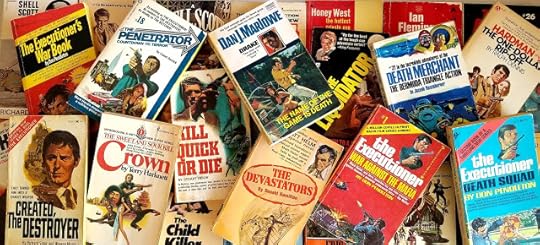 A SELECTION OF BOOKS FROMTHE CARTER COLLECTION
A SELECTION OF BOOKS FROMTHE CARTER COLLECTION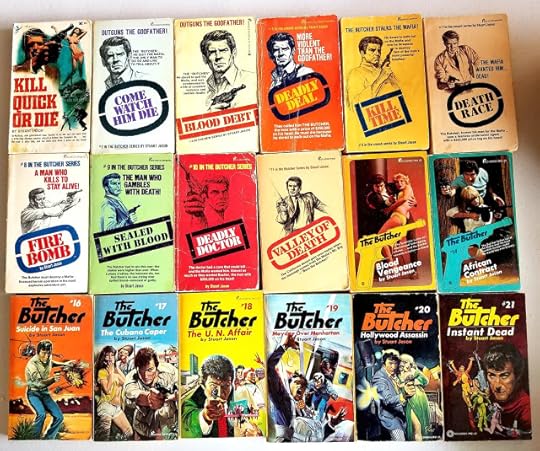
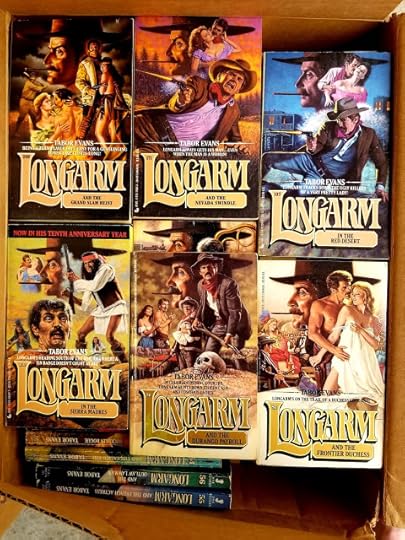
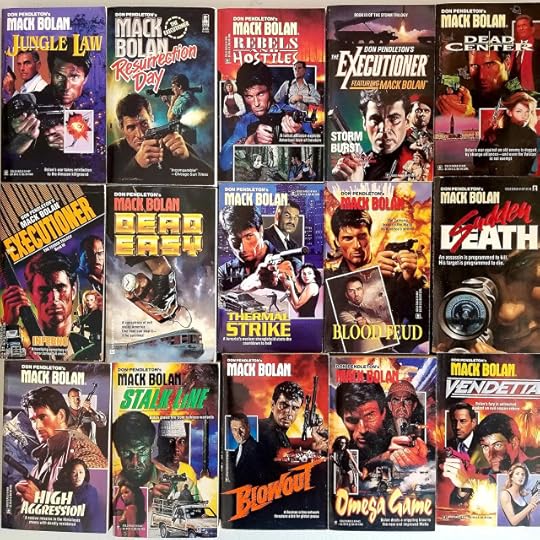
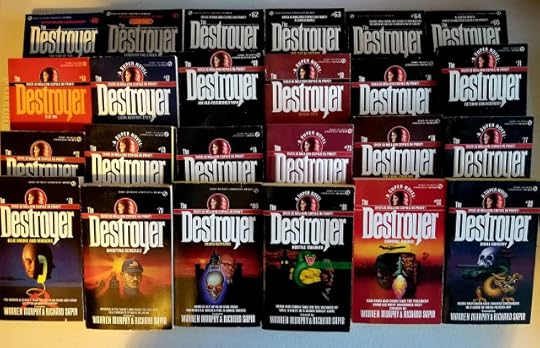
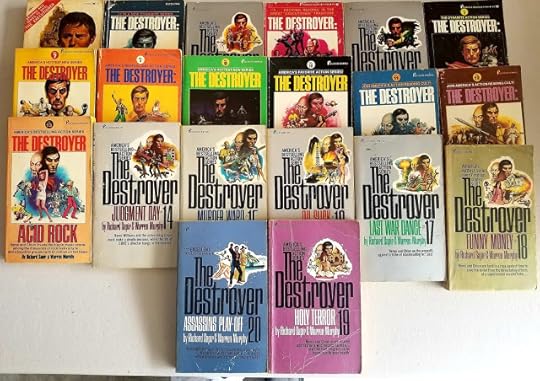
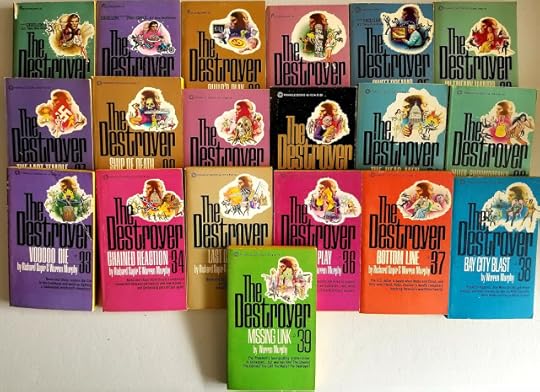
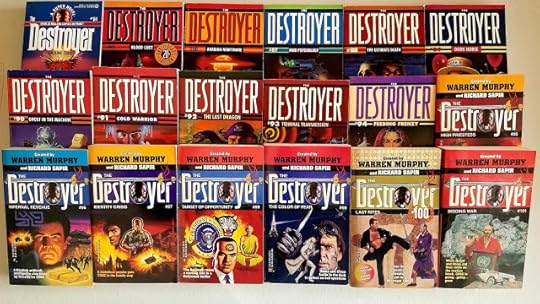
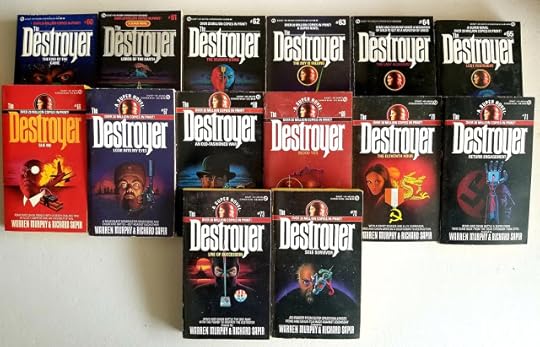
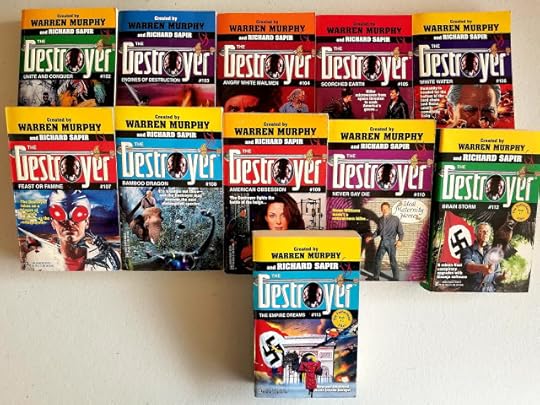
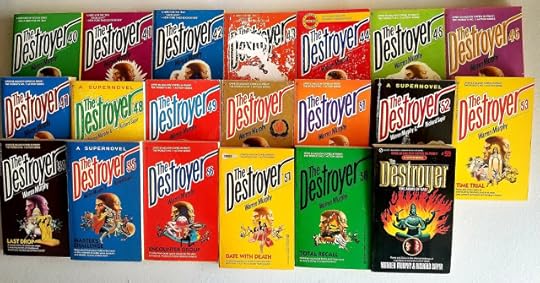
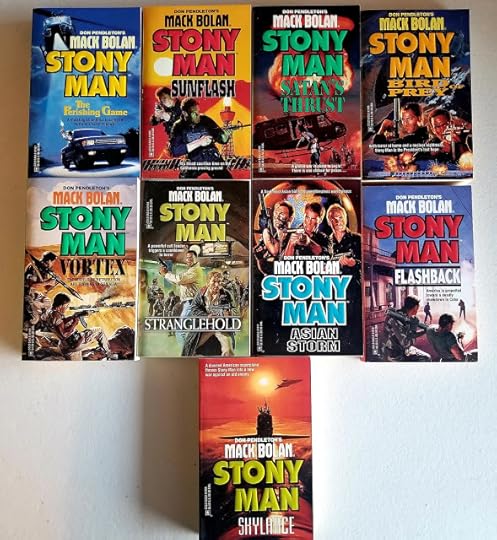
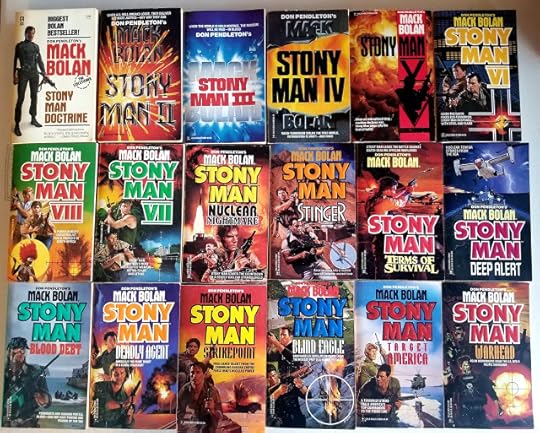
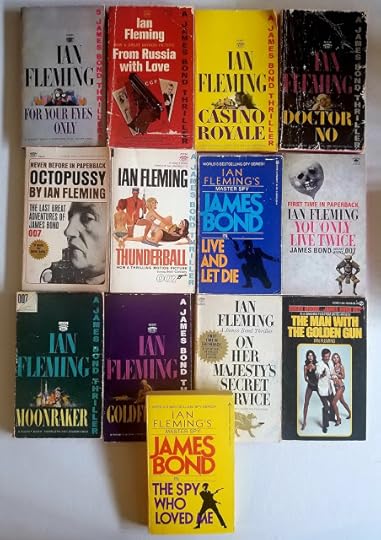
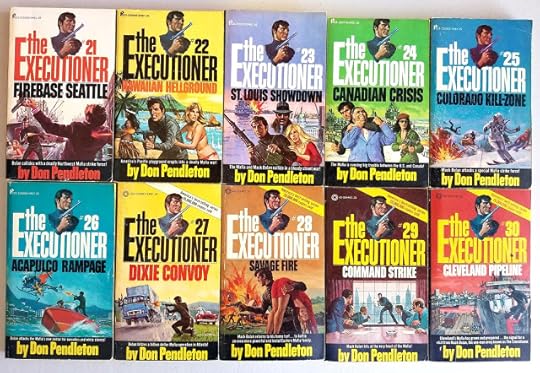
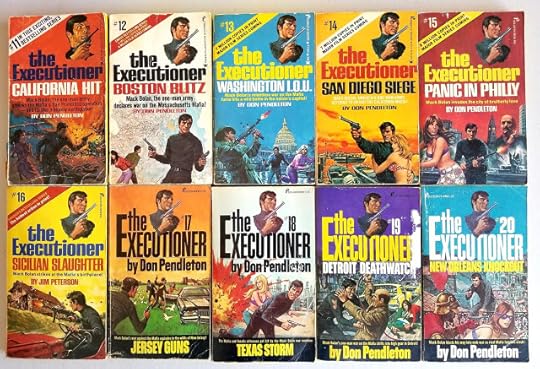
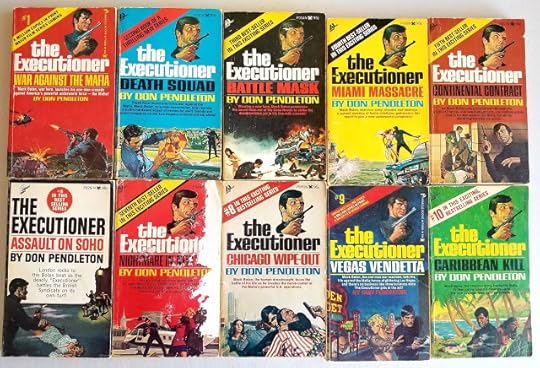
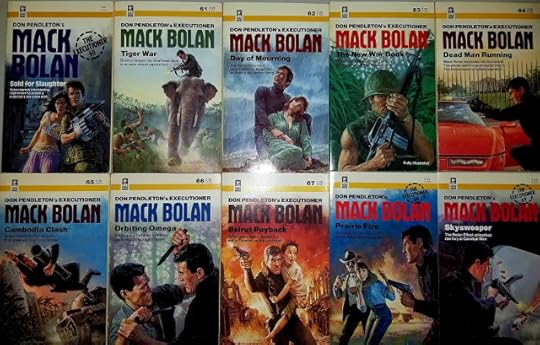
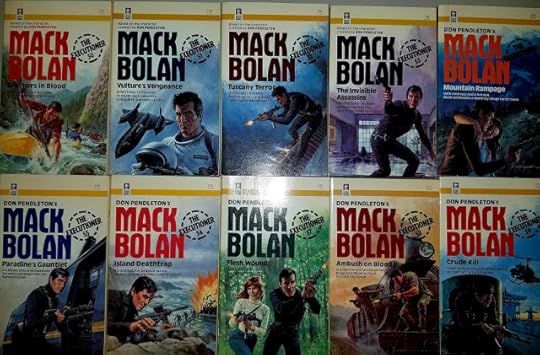
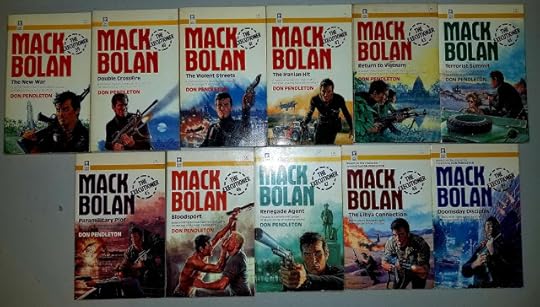
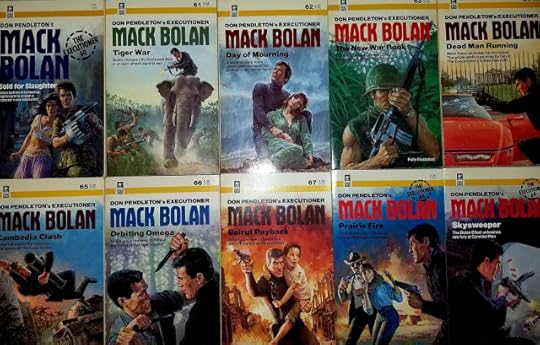
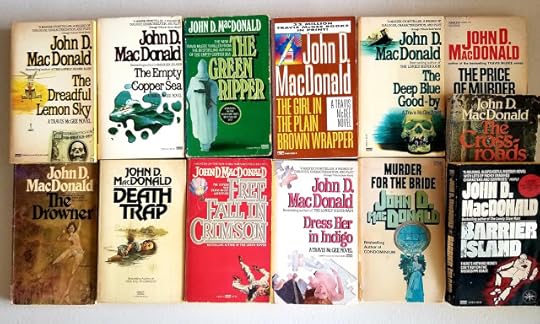
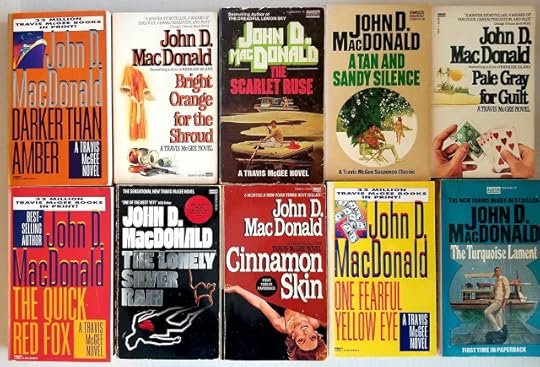
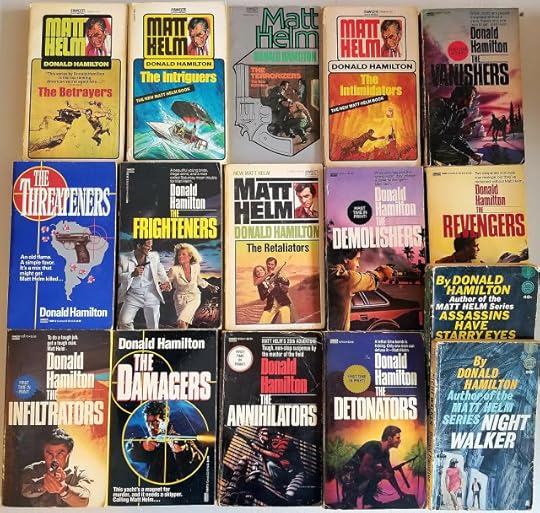
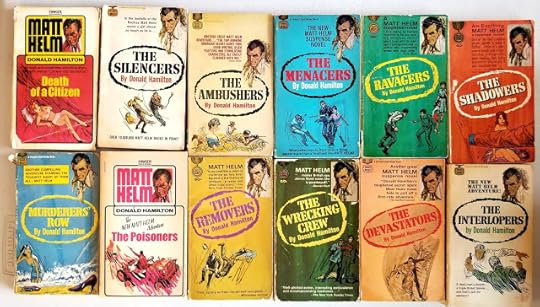
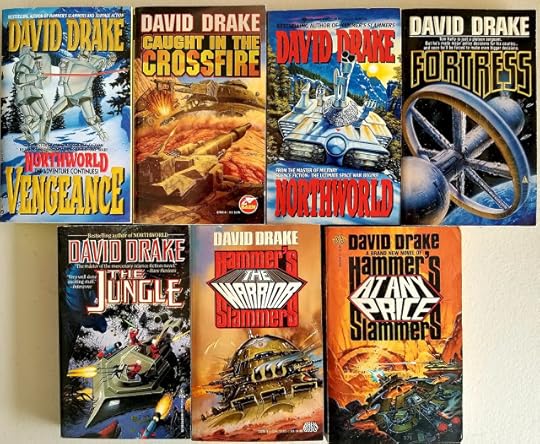
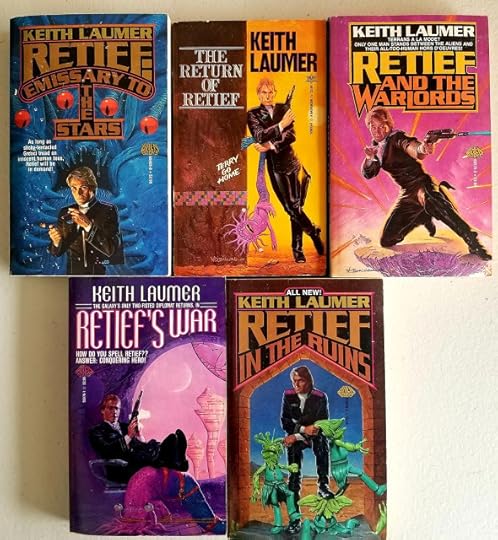
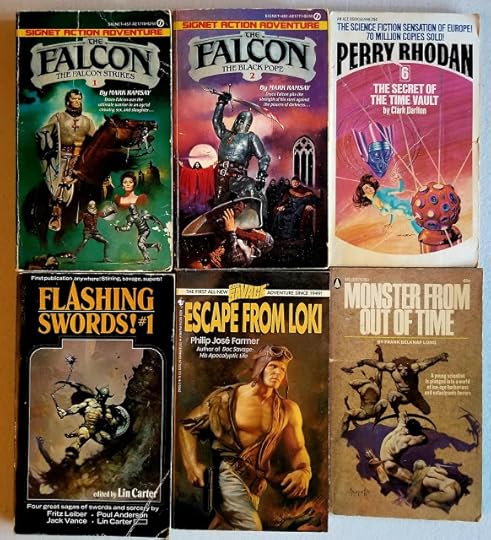
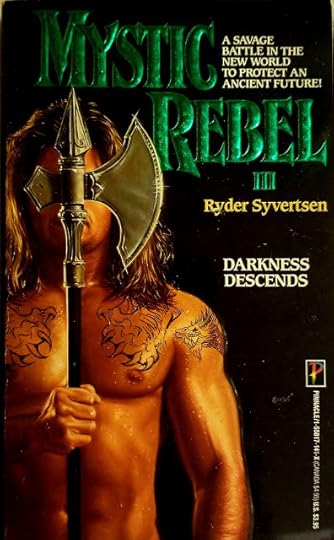
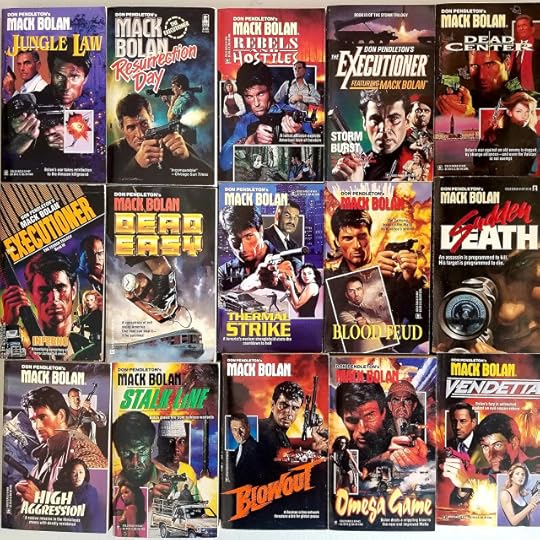
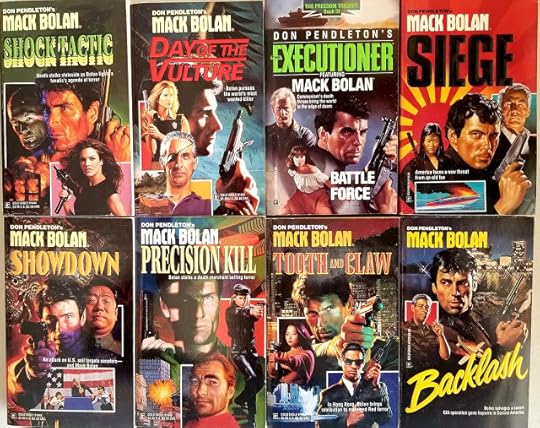
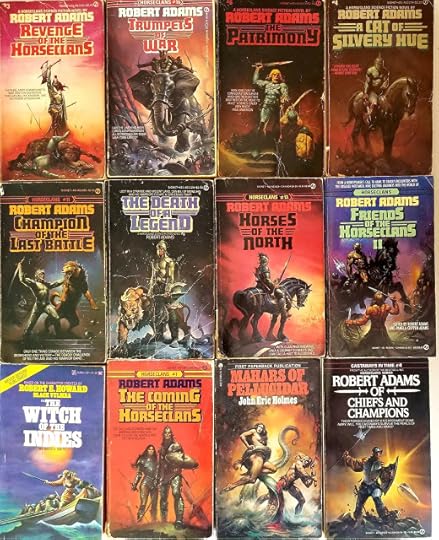
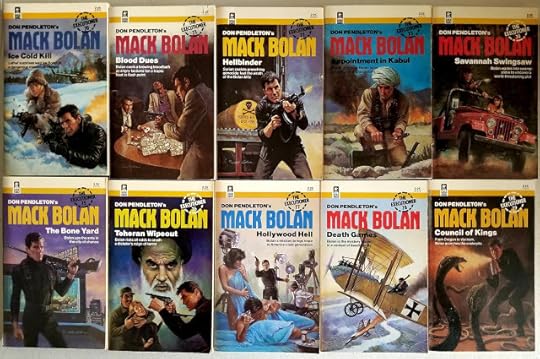
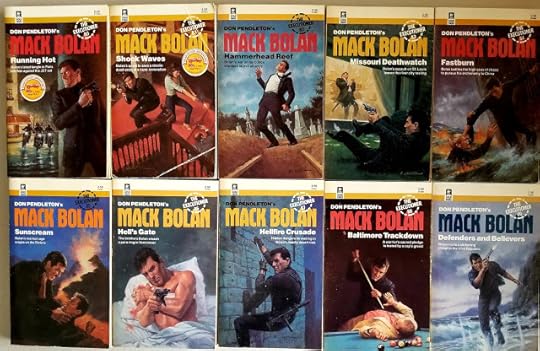
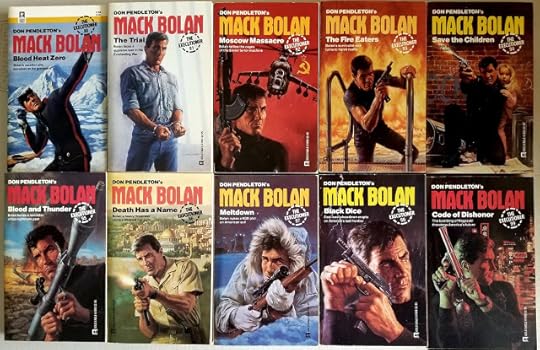
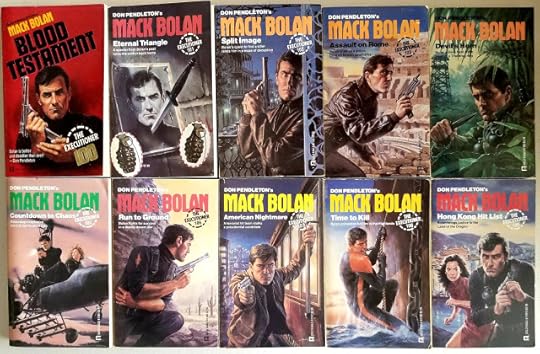
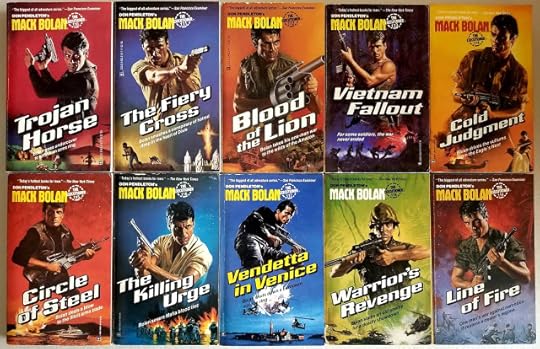
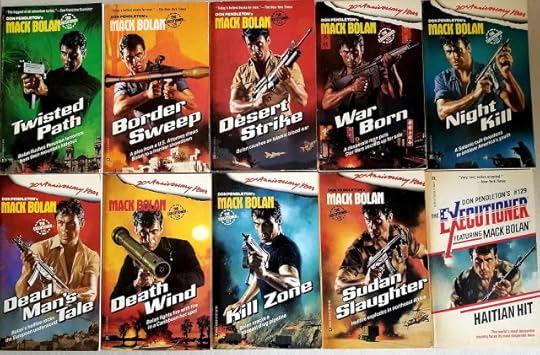
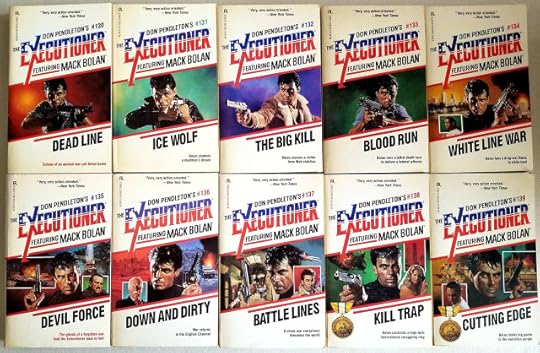
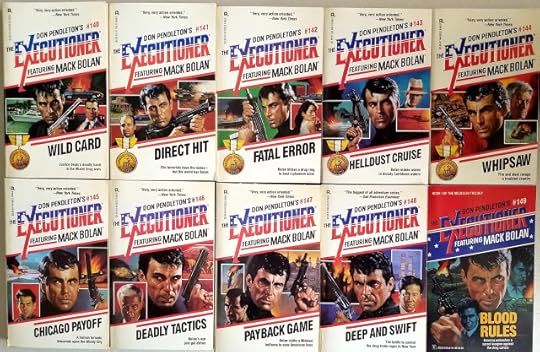
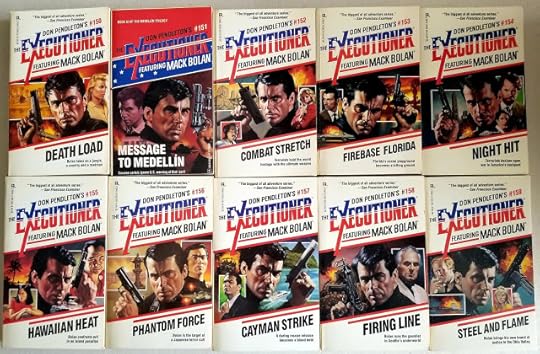
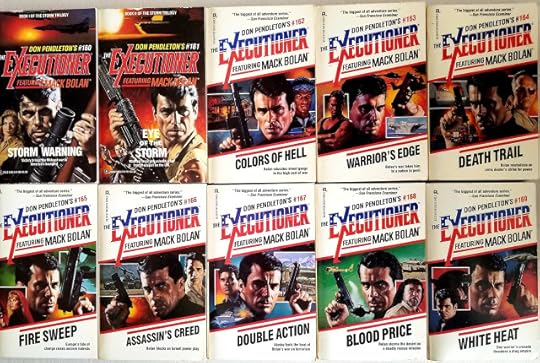
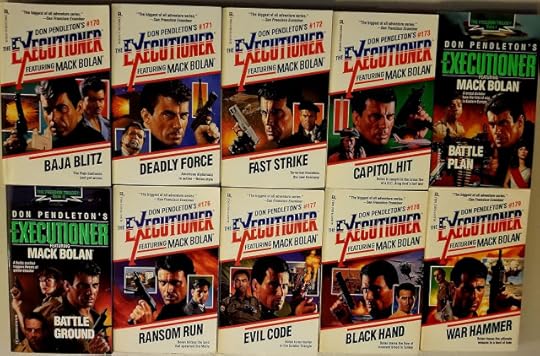
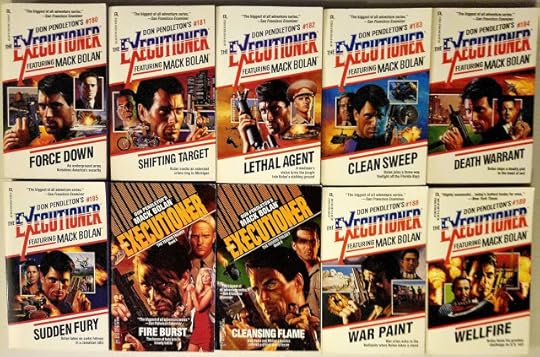
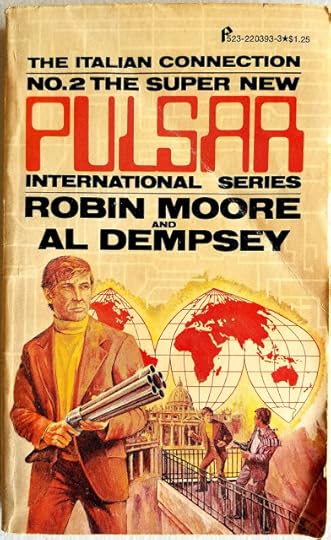
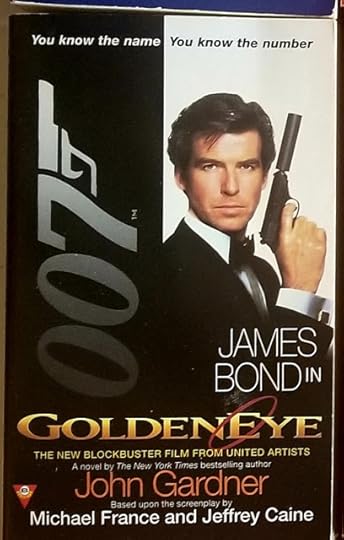
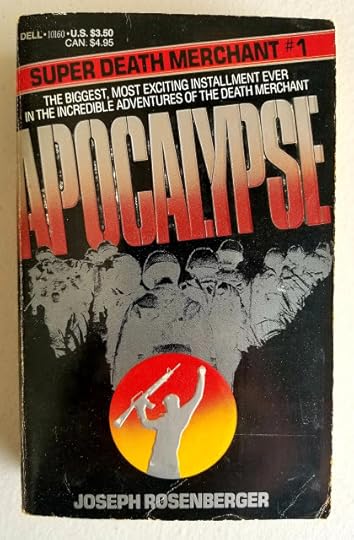
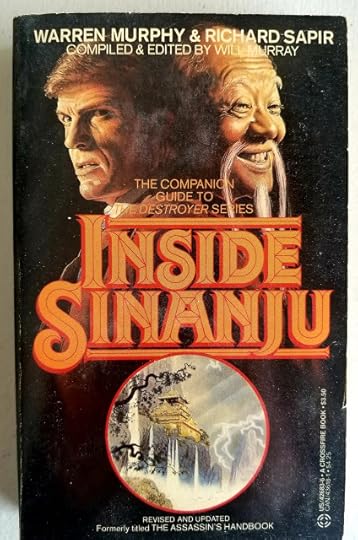
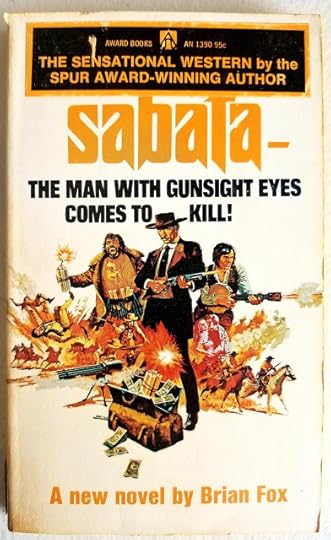
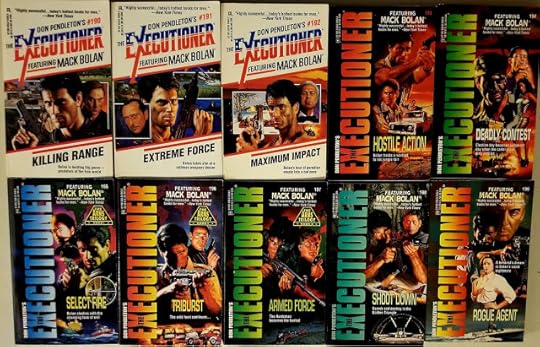
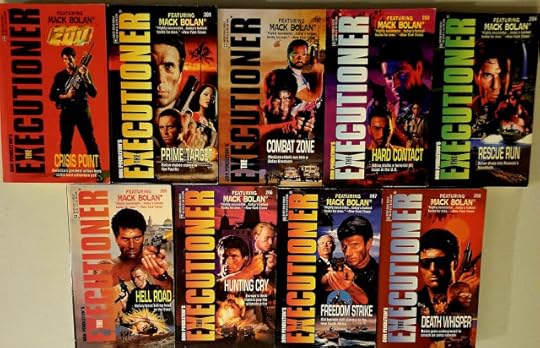
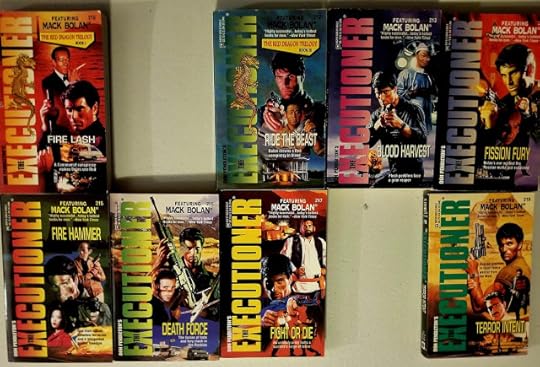
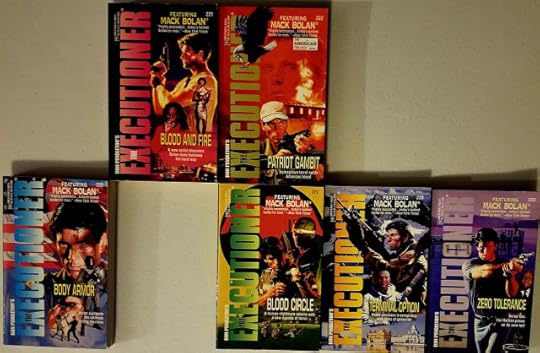
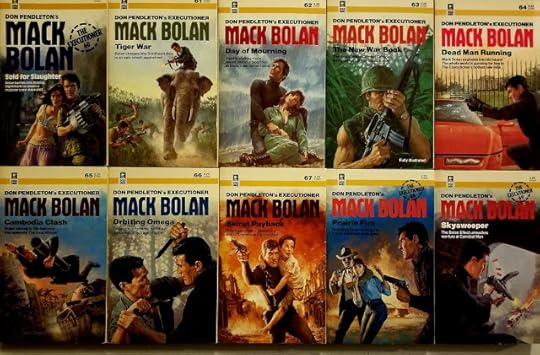
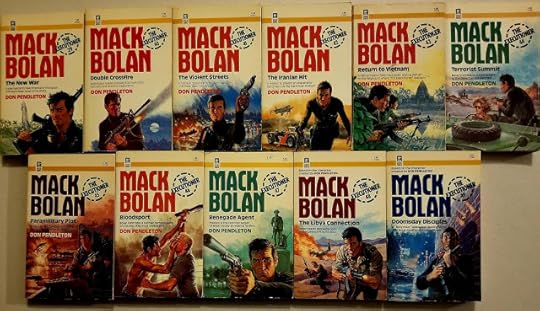
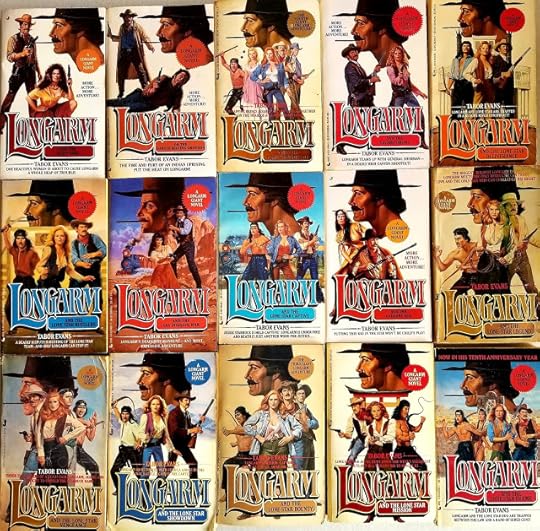
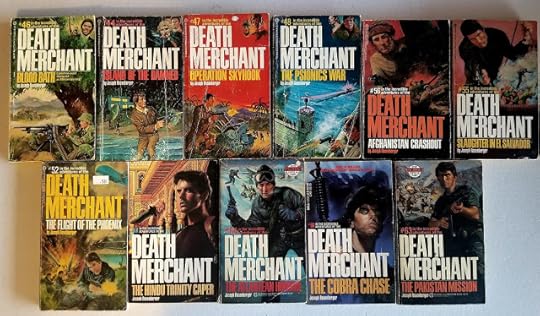
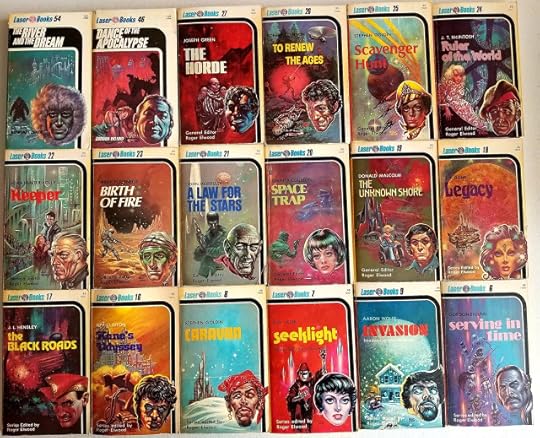
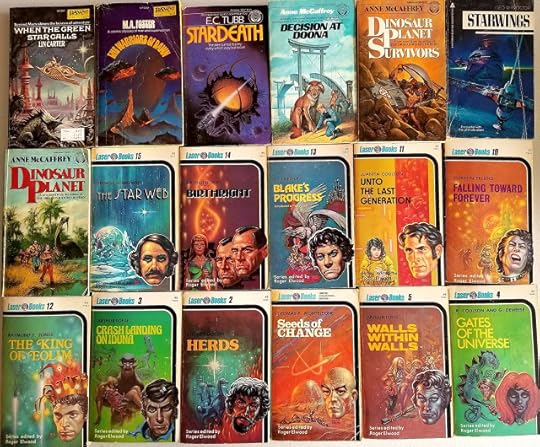
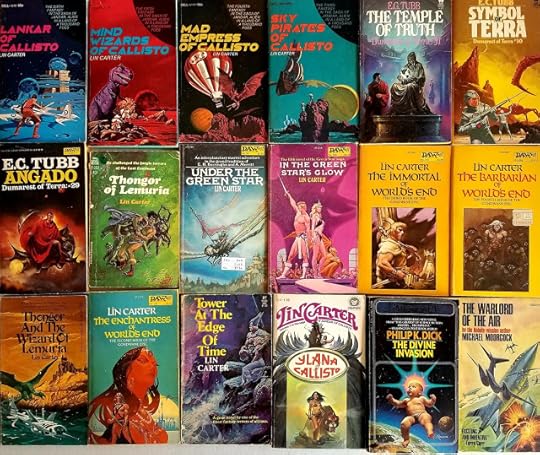
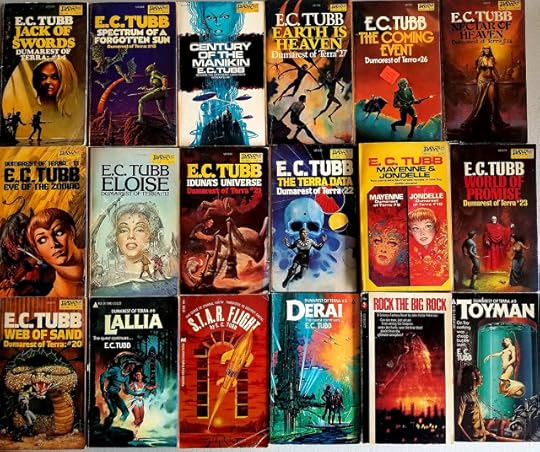
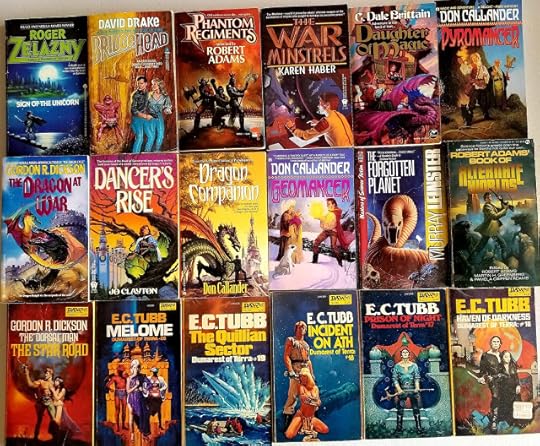
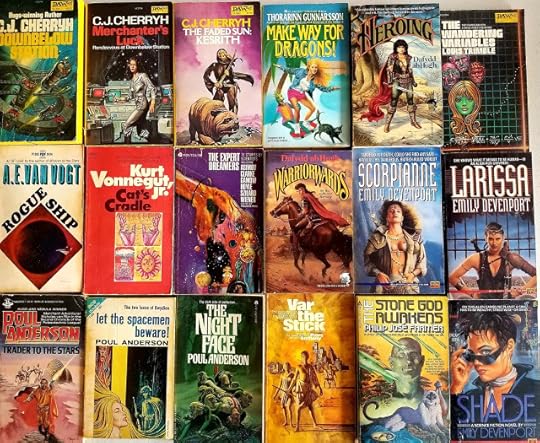
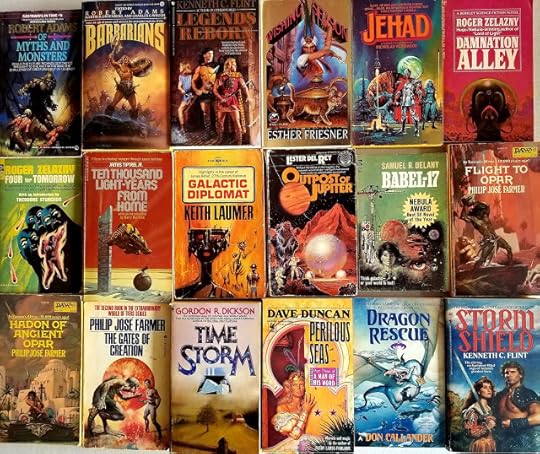
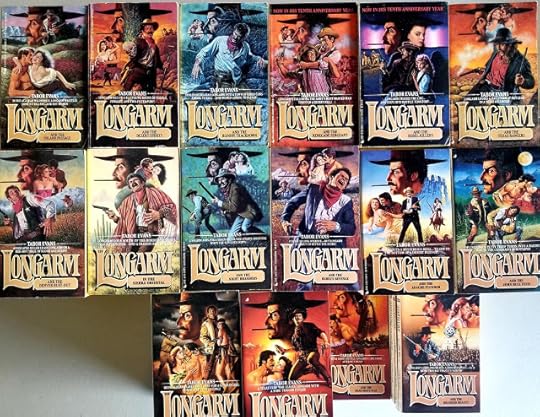
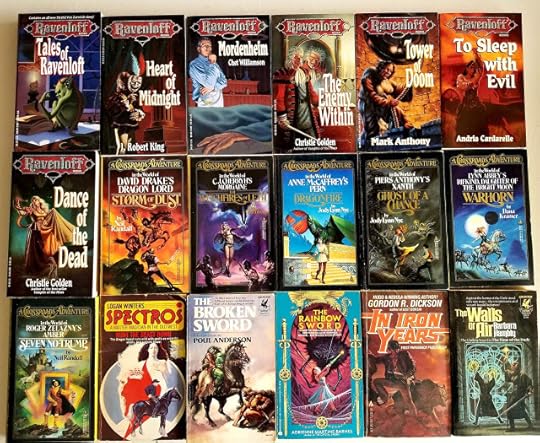
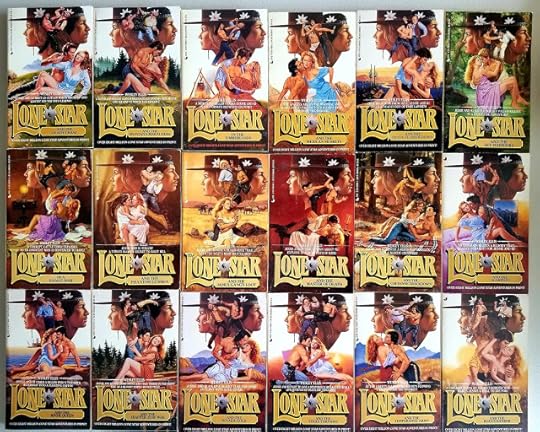
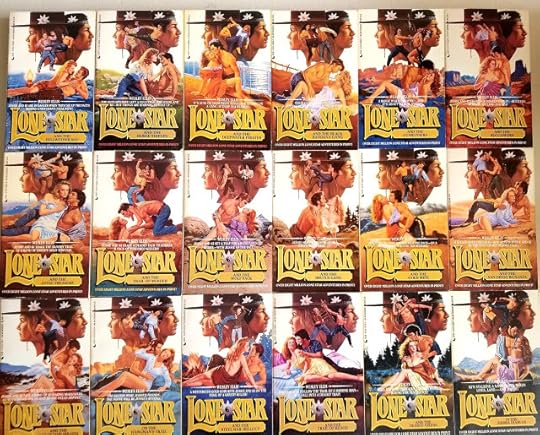
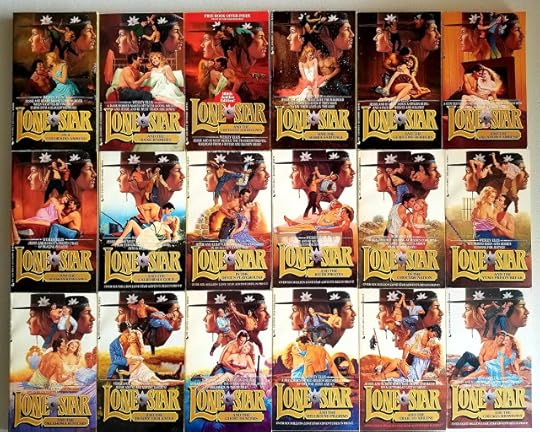
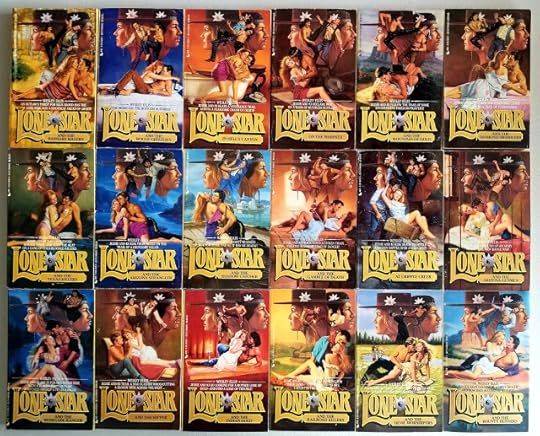
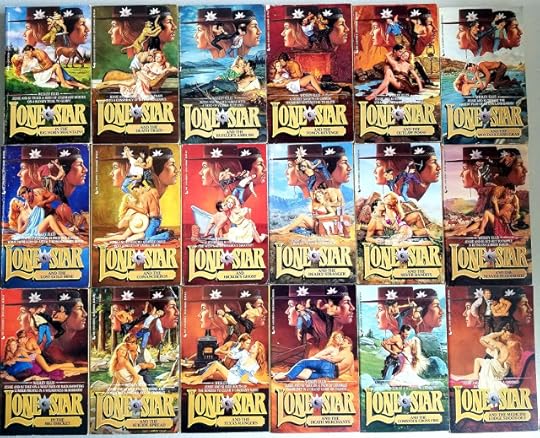
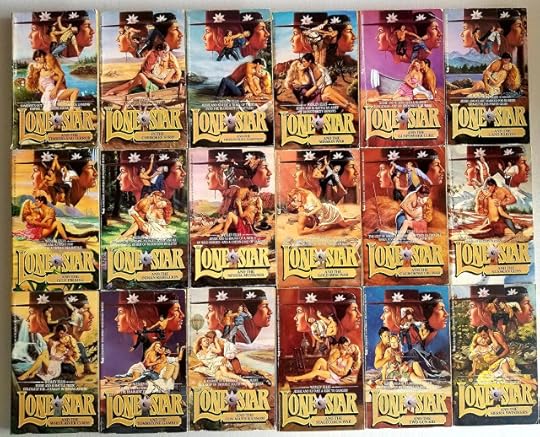
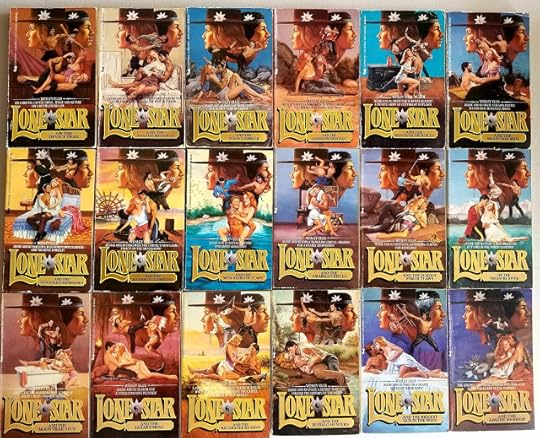
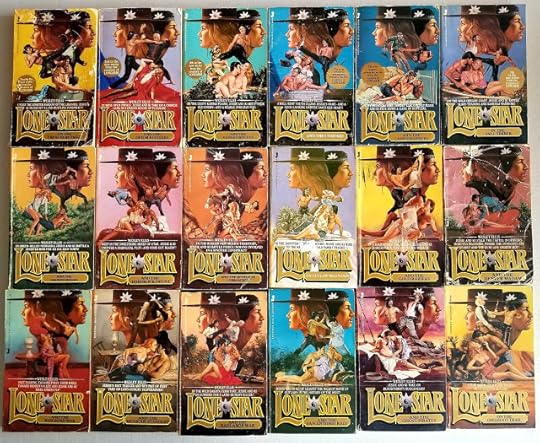
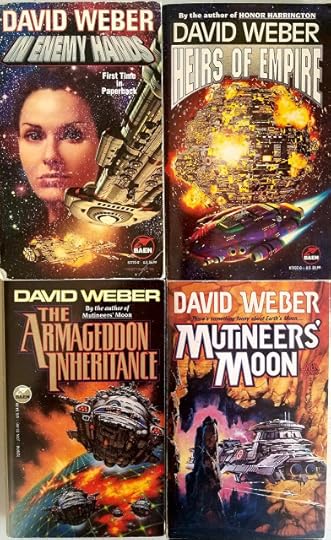
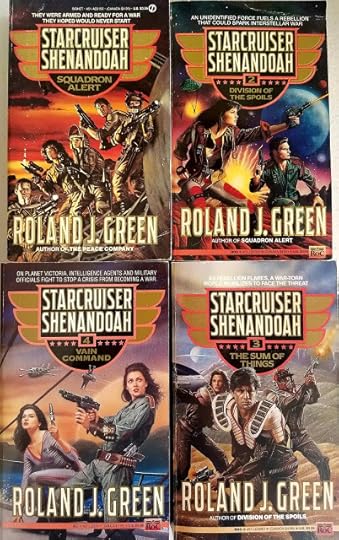
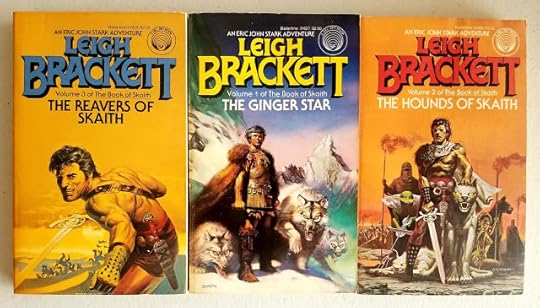
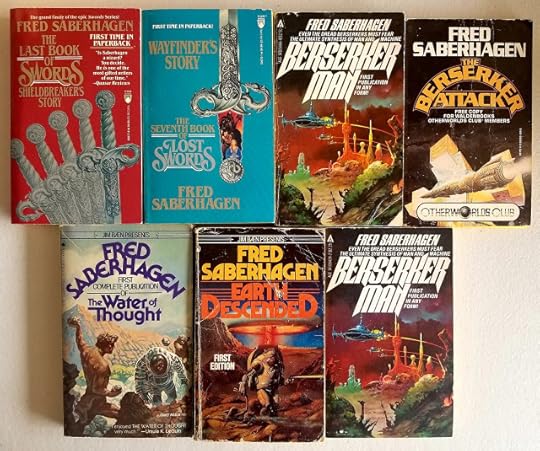
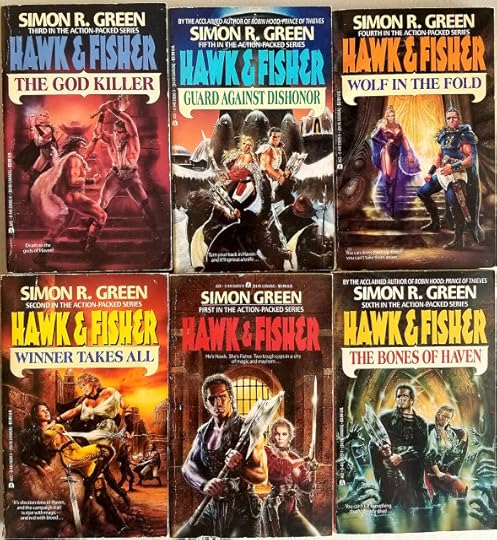
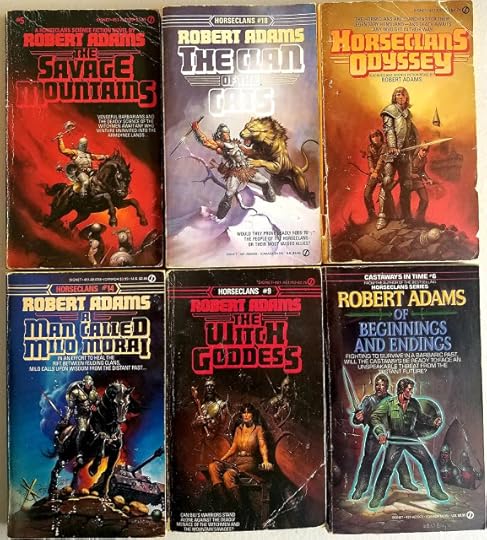
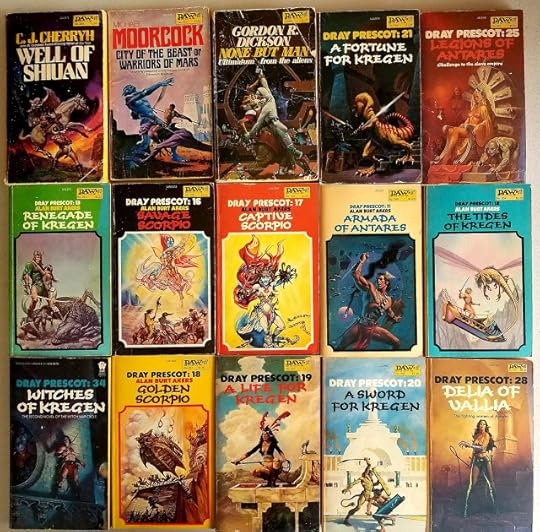
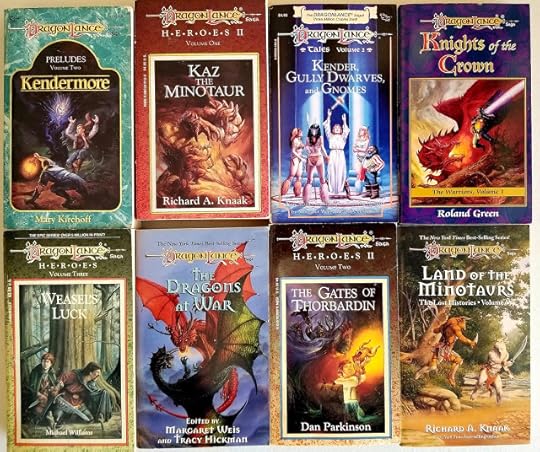
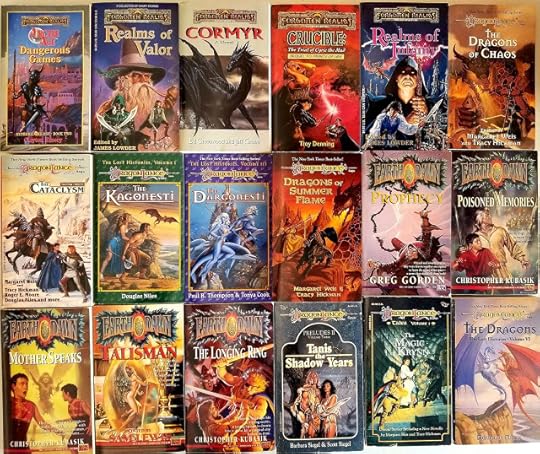
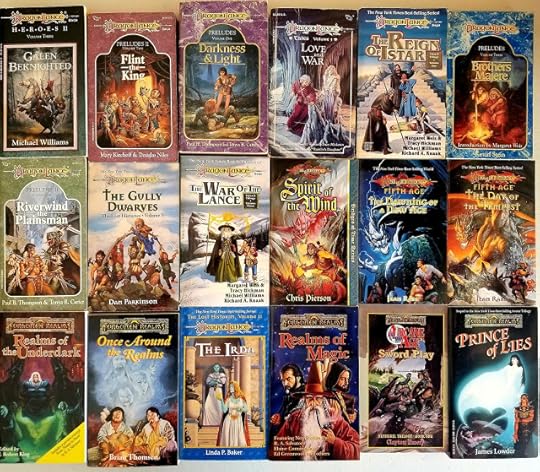
Published on August 21, 2019 18:46
July 10, 2019
42 MORE TV WESTERNS
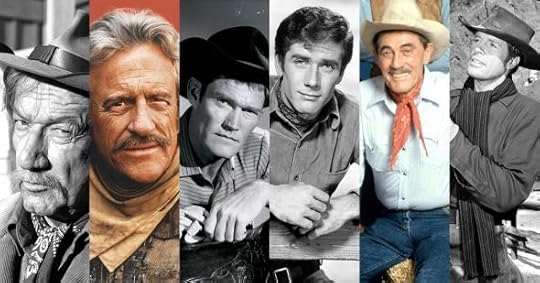 42 MORE TV WESTERNS NOTES FROM THE CUTTING ROOM FLOORHaving recently finished co-writing and editing 52 Weeks • 52 TV Westerns, I’m finding it hard to let go. Trying to limit the collection to 52 TV Westerns was near impossible. I found it much harder than with the first two collections, 52 Weeks • 52 Western Novels and 52 Weeks • 52 Western Movies.
42 MORE TV WESTERNS NOTES FROM THE CUTTING ROOM FLOORHaving recently finished co-writing and editing 52 Weeks • 52 TV Westerns, I’m finding it hard to let go. Trying to limit the collection to 52 TV Westerns was near impossible. I found it much harder than with the first two collections, 52 Weeks • 52 Western Novels and 52 Weeks • 52 Western Movies.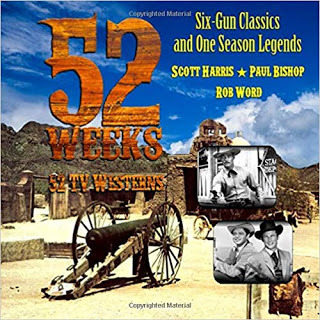 With 52 Weeks • 52 TV Westerns, I agonized over some of the shows that didn't make the cut. However, the 52 Westerns collections are not supposed to be a best of list. They are designed to be a subjective overview with writers sharing their personal connection or feelings about whatever book, movie, or TV show they are writing about. It's this emotional connection that makes the 52 Weeks • 52 Westerns books different—and IMHO better—than other related books on the subjects.
With 52 Weeks • 52 TV Westerns, I agonized over some of the shows that didn't make the cut. However, the 52 Westerns collections are not supposed to be a best of list. They are designed to be a subjective overview with writers sharing their personal connection or feelings about whatever book, movie, or TV show they are writing about. It's this emotional connection that makes the 52 Weeks • 52 Westerns books different—and IMHO better—than other related books on the subjects. However, whenever contributing editors, Scott Harris, Rob Word, and myself felt we had finalized the list of 52 TV Westers, one or the other of us would have an emergency epiphany...
”What do you mean nobody is writing up The Lone Ranger? It’s too important not to be included”...”We had someone covering The Wild Wild West, right? How come it’s not on the list? It has to be on the list”...”Where’s The Life and Legend of Wyatt Earp? Hugh O’Brian was fantastic as Earp. We can’t not include it”...
And on, and on, and on.With the sheer number of popular TV Westerns broadcast into our homes each week during the 50s and ‘60s, it was inevitable some of our favorites—and yours—would not be included. Some of the TV Westerns we did choose were not as important or popular as some of those we didn’t include, but this is due to the nature of the 52 Weeks • 52 Westerns series.
As contributing editors, our goal was to go beyond rounding up the usual owlhoots. Instead, we want the included choices to be and eclectic mix of the popular and the obscure, with each choice meaning something special to our posse of contributors. Our hope is TV Western fans will find out something new about the shows they love, and casual fans will find intriguing Westerns they’ve never seen, but can now view on DVD.
In an attempt to address some of the TV Westerns not covered in 52 Weeks • 52 TV Westerns (or at least mollify my desire to give these additional shows recognition), I’ve put together this additional list of TV Westerns I wish we’d had the room to include.

BARBARY COAST (1975)
The adventures of 19th century government agent Jeff Cable (William Shatner), and his pal, conman and gambler Cash—Cash makes no enemies—Conover (Doug McClure). In their battle against criminals and foreign spies, Cable and Conover operated out of the Golden Gate Saloon and Casino, which is owned by Cash and located on San Francisco's notorious Barbary Coast.
BAT MASTERSON (1958)
With his derby hat, his cane, and his fancy duds, famous lawman Bat Masterson (Gene Barry) uses his wits and his cane more often than his gun to defend the unjustly accused.
THE BIG VALLEY (1965)
In the 1870s, Victoria Barkley (Barbara Stanwyck) rules the family ranch located in California's San Joaquin Valley. Bank robbers, horse thieves, revolutionaries, and land grabbers keep the legitimate and illegitimate family members in the saddle.
BLACK SADDLE (1959)
Gunfighter Clay Culhane (Peter Brecks) hangs up his guns and becomes a lawyer after his brothers are killed in a shootout. Culhane was also seriously injured in the gunfight, but survived. Trying to live a quieter life, Culhane’s reputation as a gunman constantly comes back to haunt him.
BRANDED (1965)
Unjustly accused of cowardice, cavalry captain Jason McCord (Chuck Conners) is court-martialed and drummed out of the Army. Trying to prove he isn’t a coward—and keep the secret of why he was the only survivor of the battle of Bitter Creek—McCord wanders the West looking for trouble.
BROKEN ARROW (1956)
A fictionalized account of the historical relationship between Indian agent Tom Jeffords (John Lupton) and the Chiricahua Apache chief Cochise (Michael Ansara), Broken Arrow was one of the few Westerns to portray Native Americans in a positive light.

BRONCO (1958)
Former Confederate officer Bronco Layne (Ty Hardin) drifts through the Wild West signing on for odd cowboy-type jobs and into weekly encounters with the likes Wild Bill Hickok, Billy the Kid, Jesse James, Theodore Roosevelt, Belle Starr, Cole Younger, and John Wesley Hardin.
THE CALIFORNIANS (1957)
During the gold rush on the 1850s, newly arrived Mathew Wayne (Richard Coogan) takes the job as sheriff and organizes the police force in an attempt to maintain law and order in the wide open city. Along the way he trades barbs with an attorney names Pitt and becomes infatuated with the young widow Fanzler.
THE CHISHOLMS (1979)
Beginning as a TV mini-series and transitioning into weekly episodes, The Chisholms was developed by Evan Hunter—better known as Ed McBain—from his own novels. Cheated out of their land in Virginia, the Chisholms head West in 1844 encountering rough conditions, hostile Indians, and family upheaval. Hadley Chisholm (Robert Preston) was the patriarch who holds the family together with the help of his wife Minerva (Rosemary Harris).
COLT .45 (1957)
Using his cover as a gun salesman, Christopher Colt (Wayde Preston) is a government Agent tracking down notorious bad guys. Sam Colt Jr. (Donald May), Christopher’s cousin, took over the reins for several episodes. Christopher and Sam eventually worked together as The Colt Cousins until the end of the series. The show was loosely based on the film starring Randolph Scott.
DESTRY (1964)
Harrison Destry (John Gavin) is the son of legendary lawman Tom Destry (the character from the film Destry Rides Again starring Jimmy Stewart). A sheriff himself until he was framed and sent to prison, Destry now roams the West searching for the men who set him up. Destry finds himself in numerous comedic situations as he goes to great lengths to avoid violence despite always running into trouble. As star John Gavin put it, "To Destry, a hero is a man who thinks slower than a coward. While his father died with his boots on, Destry believes it is better to live with his boots on.”
FRONTIER CIRCUS (1961)
Colonel Kasey Thompson (Chill Wills) and Ben Travis (John Derek) own a one-ring traveling circus entertaining audiences throughout the 1880’s West. Shot in black and white two years after Bonanza brought color westerns to television, Frontier Circus simply fell through the cracks. However it’s worth viewing on DVD as many of the stories were non-traditional Westerns because of the circus background.
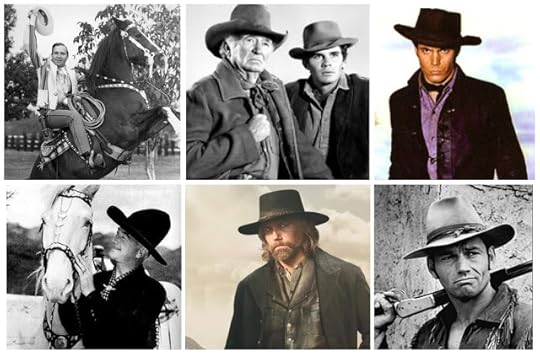
THE GENE AUTRY SHOW (1950)
One of the most recognizable of the original singing cowboys, Autry moved his show from radio to TV with relative easy. Lighthearted, with plots that were much about nothing, Autry was definitely family entertainment. My favorite Autry outing however was his debut in 1935, playing himself in the whacky serial film Phantom Empire. Autry is a singing cowboy who stumbles upon an ancient subterranean civilization living beneath his own ranch. It only gets crazier from there.
THE GUNS OF WILL SONNETT (1967)
Ex-cavalry scout and gunfighter Will Sonnett (Walter Brennan) and his grandson, Jeff (Deke Rambo), search the West for Will's son, and Jeff's father, Jim Sonnett (Jason Evers)—a former lawman turned gunslinger who is on the run. There is a lot of family angst amongst the gunsmoke.
GUNSLINGER (1961)
Little more than a twelve episode blip, the adventures of Cord (Tony Young), a young gunfighter working undercover for the local army garrison commander trying to keep peace in the territory, should have had a longer run. Cord's dark, brooding presence made him a heartthrob for female viewers, but did little to make up for the standard plots and plodding writing. The show, however, had two redeeming factors. The first was the theme sung by Western music icon Frankie Lane. Second was the dark nature of the pilot with Cord sent to bring in a war criminal from the American Civil War—a Confederate army doctor who performed medical experiments on the Union POWs at the infamous Andersonville prison camp. This was dangerous and exciting territory, but unfortunately, the following episodes were turned into trite horse operas.
HELL ON WHEELS (2011)
Former soldier and slaveholder, Cullen Bohannon (Anson Mount), is tracking a renegade band of Union soldiers who murdered his wife. His quest for vengeance ultimately brings him into the heart of the huge project of building the transcontinental railroad. This recidivist Western is an amazing blend of writing, acting, costuming, set dressing, and cinematography. It is also violent, bloody, harsh, and sometimes hard to watch despite its brilliance, or perhaps because of it.
HONDO (1967)
Based on the 1953 John Wayne film, which itself was based on an early Louis L’Amour novel, Hondo Lane (Ralph Taeger) is an ex-Confederate cavalry officer who takes an Indian bride, only to see her killed in a massacre perpetuated by U.S. Army troops. Accompanied by his dog, Sam, Hondo wanders the West in a quest protect the remaining Indians from further trouble with the Army. Buffalo Baker (Noah Beery, Jr.) often turns up as Hondo's sidekick. The first two episodes were combine as Hondo and the Apaches, a feature film distributed internationally.
HOPALONG CASSIDY (1959)
Created in 1904 by Clarence E. Mulford in a series of short stories, Hopalong Cassidy became a series of successful movies starring William Boyd, who changed Mulford’s original character to suit his own personality. When the studio moved on to other projects, Boyd risked every penny he had to buy the rights to his Hopalong films. He then turned around and sold the films to the fledgling NBC network, who broadcast them as edited episodes—making Hopalong Cassidy the first TV Western. The edited films were successful enough for NBC to order an original series of Hopalong adventures with William Boyd as the star. Even though he was dressed all in black, Hopalong was still a white knight riding his white charger, Topper, doing good across the West. Between the movies, the TV show, and the incredible merchandizing, Boyd became wildly rich.

HOW THE WEST WAS WON (1976)
Based loosely on a 1962 movie of the same name, How the West Was Won started its television run in 1976 with a two hour made-for-TV movie entitled The Macahans. The TV movie acted as a pilot for a 1977 mini-series, which ran under the original title, How the West Was Won. The successful mini-series spawned a regular How the West Was Won weekly series in 1978. While popular in the U.S., the series became hugely successful in Europe. When broadcast in Sweden, in particular, it established a devoted, if not fanatical following.
When Zebulon Macahan (James Arness), an irascible mountain man, trapper/trader, and scout working for the U.S. Army in the Indian Territories, returns to check on his family in Manassas, Virginia, he finds them preparing to head West to escape the ravages of the brewing Civil War. Because of his experience, Zeb finds himself blazing the trail with the help of his nephew Luke (Bruce Boxleitner) on the way to Oregon. They run into many setbacks along the way, forcing them to delay their travels many times as they face hostile Indians, crazed mountain men, and more trouble than any family should have to face.
In 1978, a nearly 400-page paperback novelization of the show’s early episodes was written by the prolific and versatile Lou Cameron. Sharing the title of the series, Cameron’s novelization is often confused with the novelization of the original 1962 feature film, which has the same title, but was adapted and expanded by Louis L'Amour.
IRON HORSE (1966)
In the 1880s, when Ben Calhoun (Dale Robertson) wins the half-completed Buffalo Pass, Scalplock and Defiance Line railroad in a poker game, he finds he has to fight Indians, bankers, and outlaws to complete the line. The show had a subtle underlying message of how industrial free enterprise built America. It also had a not so subtle message, especially in the first season, as Calhoon clearly cavorted with anything in skirts, including the female guest stars. There were no bedroom scenes, but viewers knew exactly what was going on behind closed doors—which was scandalous for a mid-60s TV show. The series pilot was released as the film Scalplock.
JOHNNY RINGO (1959)
The character of Johnny Ringo (Don Durant) was loosely based on the life of the notorious gunfighter and outlaw known as John Peters Ringo or John B. Ringgold, who tangled with Wyatt Earp, Doc Holliday, and Buckskin Franklin Leslie. Since it was unthinkable to have a bad guy as the hero of a Western, TV’s Johnny Ringo has turned his back on his owlhoot past and set aside his gunfighting ways to become the young sheriff of Velardi in the Arizona Territory. Like many other Western heroes, Johnny Ringo had a gimmick gun, a custom-built LeMat revolver. The LeMat featured an auxiliary shotgun barrel under its primary barrel. Many episodes found Ringo getting into scrapes where the final round in the shotgun barrel was the deciding factor.
LARAMIE (1959)
When their father is murdered by a greedy land seeker, the two Sherman brothers, Slim (John Smith) and fourteen year old Andy (Robert Crawford, Jr.), link up with drifter Jess Harper (Robert Fuller) to run a stagecoach stop for the Great Central Overland Mail Company. The money the Shermans make from running the stage stop they use to hang on to their father’s ranch. Interestingly, the show often showed the Shermans and the family cook Jonesy (Hoagy Carmichael) working on the ranch—chopping wood, cooked, washing dishes and cloths, feeding chickens, repairing roofs, and the many other chores necessary to run a ranch. The relationship between the Shermans and grim drifter Jess Harper is touchy and tenuous, but eventually moves toward trust and true friendship. By season three most of the characters and the interesting storylines that made the series different from other TV Westerns had been tossed in favor of focusing on Slim Sherman and Jess Harper and standard Western tropes.
THE LIFE AND LEGEND OF WYATT EARP (1955)
Playing fast and loose with historical facts, Wyatt Earp (Hugh O’Brian) starts out as the deputy town marshal of Ellsworth, Kansas. However, after only four episodes, he moves on to becomes town marshal in Wichita, Kansas. In the season, Wyatt moves on again when he is hired as assistant city marshal of Dodge City, all the time keeping the peace with his Buntline Special—a Colt revolver with a 12” barrel. Wyatt was portrayed as an upstanding hero, a man reluctant to kill until forced into a gunfight. This was far from the reality of the real life Wyatt Earp’s character. However, Hugh O’Brian absolutely embodied the TV show character, playing Earp with a cold nobility, a reserve, and a slightly dark edge. TV’s Earp was a well-honed knife blade cutting to the heart of every storyline.
MAKENZIE’S RAIDERS (1958)
Colonel Mackenzie (Richard Carlson), commander of the 4th Cavalry Regiment at Fort Clark located in southwest Texas, receives secret orders from U.S. President Ulysses S. Grant and Secretary of War William W. Belknap to stop bandits from crossing the Rio Grande into the United States or escaping justice by fleeing into Mexico.
Based on the book The Mackenzie Raid, the Colonel’s orders went even further. His Cavalry unit was expected to clean up the Southwest, making it a fit place for Americans to live. They were to wipe out renegades, outlaws, and murderers. If necessary, they were expected to cross the Rio Grande in pursuit of dangerous outlaws, knowing if they were captured they would be hung by the very outlaws they pursued, or if discovered they would be court martial by the United States Army.

A MAN CALLED SHENANDOAH (1965)
A man (Robert Horton) is shot and left for dead. He is found and revived by two buffalo hunters who take him to town hoping he has a bounty on his head. According to the sheriff, however, the man is not on any wanted posters, but the bigger problem is the man has no recollection of his past. Calling himself Shenandoah, a name given to him by the doctor who treats him, he set off across the West in search of his identity and to find out who . Eventually, He learns he had been a Union officer during the American Civil War—possibly being the only survivor of a massacre—is an expert card player, and might have been married, but he can uncover no definitive answers. The big moral hits in the final episode: It's not always important who you are; but it's always important what you are. Star Robert Horton Sang the show’s theme song after he wrote new lyrics to the music of American folk tune Oh, Shenandoah.
THE NINE LIVES OF ELFEGO BACA (1958)
Elfego Baca (Robert Loggia) was a real-life Mexican American lawman in the late 1800s brought to life on television in ten episodes of Walt Disney Presents. Elfego Baca was an attorney and reluctant lawman who preferred to fight outlaws using his brains rather than his guns. In 1962 a number of episodes were compiled and released as a movie under the title Six Gun Law. In the series, Elfego was often referred to as El Gato—the cat. Star Robert Loggia, of course, would later become the cat-burglar known as T.H.E. Cat.
OUTLAWS (1960)
U.S. Marshal Frank Caine (Barton MacLane) and his young deputies (Don Collier / Bruce Yarnell) take on bandit gangs, gunmen, and robbers as they bring justice to the lawless Oklahoma Badlands. The series brought an interesting twist to the TV Western. In a Wild West take on Crime and Punishment, each episode was told almost exclusively from the point of view of the Outlaws, not the lawmen. U.S. Marshal Caine and his posse were a constant threating presence to the men they were chasing—always in the distance, but always coming. In some episodes, the outlaws were presented in such an empathetic way viewers found themselves rooting for them to get away. The episodes usually ended in one of two ways, the traditional lawman finally catches the outlaw, or more interestingly, the outlaw causes his own downfall through his character flaws.
PARADISE (1988)
With a name change to The Guns Of Paradise in season three, this family oriented TV Western saw wrongly accused gunslinger Ethan Cord (Lee Horsley) confronted with raising his dead sister's four children. When he tries to settle his new found family in the town of Paradise, Cord’s gunfighter past (as it always does) continues to put him—and his sister’s children—in danger. Some episodes tried for a more human element, such as when Paradise is infested with the small pox. Like a number of other TV Westerns, Paradise found an enthusiastic and loyal audience in Scandinavian and Europe.
PONY EXPRESS (1959)
Wanted...Young expert horsemen, good moral character, ready to endure severe hardships to carry the mail 2000 miles between St. Joe and Sacramento against the impossible barriers of terrain, weather, Indians...and time.Set in 1860, the opening narration for each episode of Pony Express provided the basic storyline. The majority of episodes featured Brett Clark (Grant Sullivan) as a roving investigator for the Central Overland Express Company—better known as the Pony Express—and Donovan (Don Dorrell), a young Pony Express rider, solving the many problems of delivering the mail.
QUEEN OF SWORDS
In 1817, a young Spanish aristocrat, Tessa Alvarado (Tessie Marie Santiago), returns to Spanish California after the death of her father and finds her home in ruins, her father's manservant reduced to stealing. The town where she was born is run by a militaristic governor who abuses his power, resulting in the miscarriage of justice and the poor living conditions of his subjects. Upset about the state of her birthplace and the murder of her father, Tessa's path is revealed to her in a mysterious dream where her father comes to her and talks of his murder, his hidden gold, and of his "Avenging Angel." She will take up arms to protect the people from the town's governor and to avenge her father's death. Tessa will do this in disguise behind a mask, becoming that "Avenging Angel," The Queen of Swords. As the Queen of Swords, Tessa becomes a vision of hope for the people who live in her long oppressed town.

THE ROUGH RIDERS (1958)
In a pre-automobile version of Route 66, ex-Union Captain Jim Flagg (Kent Taylor), former Confederate Lieutenant Colin Kirby (Jan Merlin), and former Union Sergeant Buck Sinclair (Peter Whitney) travel the post-Civil War West together on the lookout for trouble and badguys. Flagg is the gallant authority figure; Kirby is jaunty and self-confident; and Sinclair is an imposing, jack-of-all-trades, out of the Tennessee hills. In one episode, the Confederate Kirby gives a brief explanation of why a Reb is travelling with two Yanks by revealing the two Union vets saved his life. This was a buddy show with the three leads seeming to genuinely like one another, which was by far the biggest draw of the show.
THE ROY ROGERS SHOW (1951)
The announcer at the top of every episode described the show best—The Roy Rogers Show, starring Roy Rogers, King of the Cowboys; Trigger, his golden palomino; and Dale Evans, Queen of the West; with Pat Brady, his comical sidekick; and Roy's wonder dog, Bullet. With all those players in place there was still room for Dale Evans’ horse Buttermilk, and Pat Brady’s seemingly possessed Jeep Nellybelle. Roy owned the Double D Ranch outside the fictional Mineral City. Dale Evans was the proprietress of the Eureka Café and Hotel. Pat Brady was Roy’s hapless sidekick, employed at the Eureka Café as Dale Evans’ cook. All of the above blended—without explanation—traditional 19thcentury cowboys into a strange mash-up with 20th century automobiles, telephones, and electric lighting. In stories aimed at a juvenile audience, Roy, Dale, Pat, and their collection of celebrity animals and Jeep regularly rescued the weak and helpless from Snidely Whiplash type villains, all the while teaching lessons on gun safety or natural resources, and delivering the occasional (standard for the day) Christian message.
SHANE (1966)
Based on the 1949 book and the 1953 movie, Shane (a pre-Kung Fu David Carradine) was a former nomadic gunslick who sometimes skirted the edges of the law. The show was mostly remarkable for its revered ancestry, but lost the point of the original source material, which was Shane leaving at the end. In the series, Shane tries to put his past behind him by accepting a job as a hired-hand at a the Starett family farm, which is owned by a comely widow (Jill Ireland), her young son (Christopher Shea), and her father (Tom Tully). For no apparent reason the series spelled Starett with only one ‘r’ instead of two as in the book and movie.
Before long, Shane finds himself having to deal with Rufe Ryker (Bert Freed), a ruthless anti-sodbuster land baron determined to either drive the widow Starett off her land, or if worse comes to worse, marry her. The series only lasted seventeen episodes as it was scheduled on Saturday nights against the ratings blockbuster that was The Jackie Gleason Show.
SHOTGUN SLADE (1959)
At a time when TV crime shows were beginning to chip away at the popularity of the TV Western, Shotgun Slade (Scott Brady) made an attempt to have it both ways. Instead of a lawman, bounty hunter, or drifting cowpoke, Slade was one of the West’s first independent private eyes. As such, he hired out much like a Wild West version of the two-fisted private eye shows, such as Peter Gunn, which were becoming popular. Slade also shared another trait with Peter Gunn. Instead of a traditional Western theme and soundtrack, Shotgun Slade featured a modern jazz score, which was anachronistic, but certainly set the show apart from other TV Westerns.
And then there was the reason for the shotgun part of Shotgun Slade. Like Wanted: Dead or Alive and The Rifleman, Shotgun Slade had a gimmick gun—a combination shotgun with an upper and lower barrel. The lower barrel fired a 12-guage shotgun shell, while the top barrel fired a .32 caliber rifle bullet. The idea was this gave Shotgun Slade the ability to hit targets at both close range and at distance with the same gun. The logic of this might be shaky, but the firearm was definitely as cool as the show’s soundtrack.
STONEY BURKE (1962)
This moody, nori-tinged, rodeo drama channels the bleak message of the movie Lonely Are the Brave, in which the last of the cowboys finds his way of life disappearing. The quietly noble Stoney Burke (Jack Lord) tries to stop the process as he competes to become the world champion saddle bronc rider and win rodeo’s Golden Buckle. A couple of Stoney’s pals come along for the bumpy ride. The shifty, but loveable Ves Painter (Warren Oates) often comes close to stealing the show, while E.J. Stocker (Bruce Dern) is more downbeat.
However, what makes this show so special happened behind the scenes. Producer/creator Leslie Stevens wrote all the earliest and clearly understood the characters and the underlying themes of the show. Conrad Hall's stunningly beautiful black and white photography gave the show a look unlike any other TV Western of the same time period. And there was also Dominic Frontiere's rousing theme music, which never failed to get a response from viewers.
TALES OF THE TEXAS RANGERS (1955)
In a cool time altering twist on the standard TV Western, Texas Rangers Jace Pearson (Willard Parker) and Clay Morgan (Harry Lauter) would be in 1840s Texas one week, but find themselves in a modern day setting the next week. This was a unique dramatic device, which viewers appeared to accept and take in stride. The show was also possibly the first TV or movie Western to feature the walk—where all the characters join up to walk into danger together. This has been seen over and over again in every Western from Tombstone to The Wild Bunch. Each episode of Tales of the Texas Rangers would start with one Ranger walking down the street only to be joined by another, and another, until he had a whole company with him by the end of the opening walk. The show would end by reversing this scene.
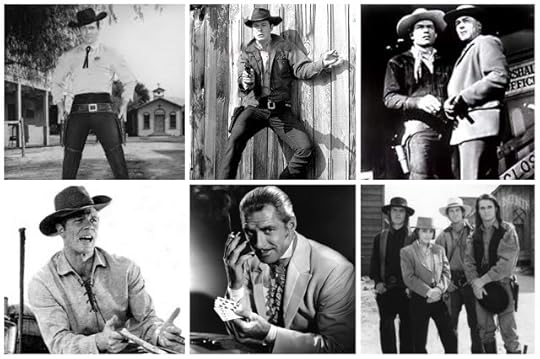
TOMBSTONE TERRITORY (1957)
In this respectable second tier TV Western, tough Sheriff Clay Hollister (Pat Conway) keeps the law in Tombstone, Arizona—the Town Too Tough To Die—with the support of Harris Claibourne (Richard Eastham) editor of the local The Tombstone Epitaphnewspaper. Each episode would begin with a voice over narration by Claibourne stating the evening’s episode was based on a story covered by his newspaper.
TRACKDOWN (1957)
Introduced on an episode of Zane Grey Theater, Texas Ranger Hoby Gilman (Robert Culp) traveled the West tracking down wanted men. While some episodes were inspired by the files of the Rangers, Hoby eventually settled down and acted as the sheriff of the fictional town of Porter, Texas. He would still occasionally venture out into the wider Lone Star State to pursue fugitives, but most of the episodes became town centered. Trackdown carried the endorsement of both the State of Texas and the Texas Rangers, dual accolades no other television series was ever granted. Trackdown is also known for an episode where Steve McQueen appeared as bounty hunter Josh Randall for the first time before being spun-off into its own show, Wanted: Dead or Alive.
26 MEN (1957)
Based on real life events, 26 Men acted as a bridge as TV Westerns transformed from kid friendly Westerns—The Roy Rogers show, Hopalong Cassidy—and adult oriented Westerns such as Have Gun Will Travel. Led by Captain Thomas H. Rynning (Tristram Coffin) and Ranger Clint Travis (Kelo Henderson), the 26 Arizona Rangers were expert horsemen, trackers and marksmen. Because the force was small and their territory huge, they were equipped with the best horses and the most modern weapons. The show also had a very cool theme song with a driving beat...This is the story of 26 men who rode the Arizona territory; 26 men who lived to ride again rode out to answer duty's call; 26 men who lived to fight again rode out for the right and the liberty of all...
WHIPLASH (1959)
Set in the 1860s, Whiplash is a kangaroo Western (filmed in Australia) in which Christopher Cobb (Peter Graves) founds and runs Australia's first stagecoach line, Cobb and Co. Cobb did not carry a pistol, but he efficiently used a stockwhip to settle disputes. The series is mostly notable for two of its writers—Gene Roddenberry and Harry Julian Fink.
YANCY DERRINGER (1958)
A former Confederate Army captain, Derringer (Jock Mahoney), now a gentleman adventurer and gambler, returns to New Orleans three years after the end of the Civil War. Widely respected in New Orleans society as a southerner who never surrendered, Derringer is recruited by the Federal City Administrator, John Colton, to work as a secret agent answering directly to Colton. The series was based on a 1938 short story about a destitute Southern aristocrat and troublemaker written by Richard Sale, one of the highest-paid pulp writers of the era.
THE YOUNG RIDERS (1989)
Fictionalized account of a group of young Pony Express riders—some younger versions of legendary Western figures—based at the Sweetwater Station in the Nebraska Territory during the years leading up to the American Civil War. The taskmaster is Aloysius Teaspoon Hunter (Anthony Zerbe), a former Texas Ranger and one of the few survivors of the Battle of the Alamo. Louise Lou McCloud (Yvonne Suhor) impersonates a man so she can join the riders, but The Kid (Ty Miller), a soft-spoken southerner, finds her out and begins to fall in love with her. Complications ensue.
Published on July 10, 2019 11:28
June 13, 2019
FISTICUFFS, PALOOKAS, AND NOIR
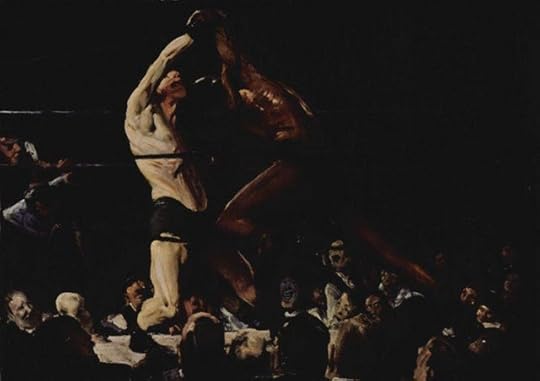 FISTICUFFS, PALOOKAS, AND NOIRBoxing and noir go together as smoothly as a one-two combination punch. The inherent qualities of both noir and boxing, desperation, bad choices, violence, tension, humanity stripped bare, combine for a marriage made in Hell.
FISTICUFFS, PALOOKAS, AND NOIRBoxing and noir go together as smoothly as a one-two combination punch. The inherent qualities of both noir and boxing, desperation, bad choices, violence, tension, humanity stripped bare, combine for a marriage made in Hell. 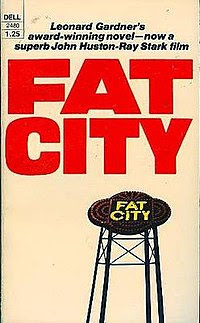 We’re not talking the Rockys of the boxing world here. We’re not talking the life affirming, if you punch hard enough, sooner or later you’re gonna be a contender, kind of boxing stories. We’re talking about the down and dirty, punch drunk, cauliflower-eared, in bed with the mob, no hope fighters who populate such novels as Fat City (Leonard Gardner), Ringside Jezebel (Kate Nickerson), The Leather Pushers (H. C. Witwer), The Bruiser (Jim Tully), or Iron Man (W. R. Burnett).
We’re not talking the Rockys of the boxing world here. We’re not talking the life affirming, if you punch hard enough, sooner or later you’re gonna be a contender, kind of boxing stories. We’re talking about the down and dirty, punch drunk, cauliflower-eared, in bed with the mob, no hope fighters who populate such novels as Fat City (Leonard Gardner), Ringside Jezebel (Kate Nickerson), The Leather Pushers (H. C. Witwer), The Bruiser (Jim Tully), or Iron Man (W. R. Burnett). There’s always the classic femme fatale involved in these tales–usually a high class socialite who gets her slumming hooks into the blue collar fighter and plays him for a sap. She’s usually responsible for pitting the palooka against the mob–you know, the bent-nosed guys looking to take over the fight racket by making the hero take a dive in the 4th round.
The low end of boxing has long fascinated writers. The late Budd Schulberg, author of the novel and screenplay On the Waterfront (the classic shoulda-woulda-coulda been a contender tale), also wrote The Harder They Fall, which has lost none of its power since its first publication almost fifty years ago.
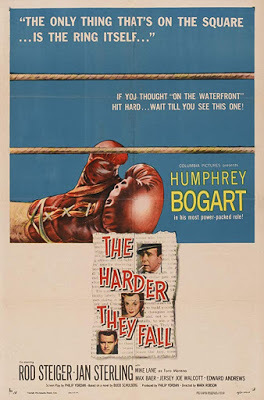 Made into a 1956 noir film, The Harder They Fall starred Humphrey Bogart in his last role as a destitute sports writer involved with mobster Rod Steiger. Bogart puts a punch drunk boxer in harm’s way believing he can convince him to throw a fight, but when the boxer decides against the dive, Bogart finds himself complicit in the boxer’s avoidable death.
Made into a 1956 noir film, The Harder They Fall starred Humphrey Bogart in his last role as a destitute sports writer involved with mobster Rod Steiger. Bogart puts a punch drunk boxer in harm’s way believing he can convince him to throw a fight, but when the boxer decides against the dive, Bogart finds himself complicit in the boxer’s avoidable death. Trying to convince the boxer, Toro, to throw the fight, Bogart’s dialogue brings not only the sport, but the fight fans into disrepute, “What do you care what a bunch of bloodthirsty, screaming people think of you? Did you ever get a look at their faces? They pay a few lousy bucks hoping to see a man get killed. To hell with them! Think of yourself. Get your money and get out of this rotten business.”
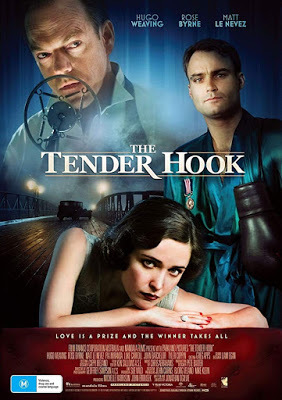 Another example of film noir’s take on boxing would be 2008’s The Tender Hook. Set in 1930′s Sidney, Australia, the traditional mob boss’ girlfriend falls for a boxer and starts a steamy affair that ends in bloodshed. The film stars Hugo Weaving as McHeath (the seedy mobster/boxing promoter) and Rose Byrne as McHeath’s girlfriend (the requisite femme fatale) who falls for McHeath’s new boxer played by Matthew Le Nevez. The story is standard fare, but its stellar cast really brings it to life.
Another example of film noir’s take on boxing would be 2008’s The Tender Hook. Set in 1930′s Sidney, Australia, the traditional mob boss’ girlfriend falls for a boxer and starts a steamy affair that ends in bloodshed. The film stars Hugo Weaving as McHeath (the seedy mobster/boxing promoter) and Rose Byrne as McHeath’s girlfriend (the requisite femme fatale) who falls for McHeath’s new boxer played by Matthew Le Nevez. The story is standard fare, but its stellar cast really brings it to life. The best of all boxing noir films, however, is 1949’s The Set-Up starring Robert Ryan as over-the-hill boxer Bill 'Stoker' Thompson, who insists he can still win.
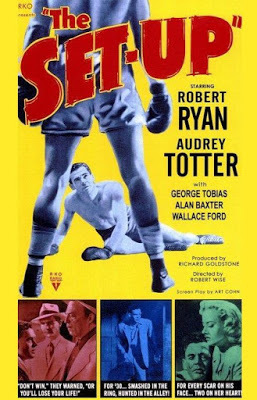 Despite the pleas of his sexy wife Julie to quit, Stoker agrees to a bout with mob-backed fighter Tiger Nelson. Stoker’s manager, Tiny, is so confident Stoker will lose, he takes money from Little Boy, the tough mobster behind Tiger, to guarantee Stoker will take a dive. The problem is, Tiny doesn’t tell Stoker about this arrangement.
Despite the pleas of his sexy wife Julie to quit, Stoker agrees to a bout with mob-backed fighter Tiger Nelson. Stoker’s manager, Tiny, is so confident Stoker will lose, he takes money from Little Boy, the tough mobster behind Tiger, to guarantee Stoker will take a dive. The problem is, Tiny doesn’t tell Stoker about this arrangement.Directed by Robert Wise, The Set-Up is brilliantly told in real time. The tension builds as Stoker stalks Tiger Nelson across the ring, determined to win, yet unaware of the tragic fate awaiting him if he does.
At the start of the fourth round of the vicious match with the much younger and heavily-favored Tiger, Stoker learns about the fix, but refuses to give up. Director Wise makes the most of every sweat-flecked second of celluoid. The fight scenes are filled with close-ups of faces burning with fear, bloodlust, and desperation–turning the screws of this tension filled gem.
With the films in mind, noir fans can fire up their DVD players, or dig deep into the catalogs of their favorite streaming service, put up their dukes, and settle in for a night of fisticuffs, palookas and noir. . .But they best watch out for that bad left hook.
Published on June 13, 2019 23:06
May 16, 2019
W. GLENN DUNCAN AND RAFFERTY
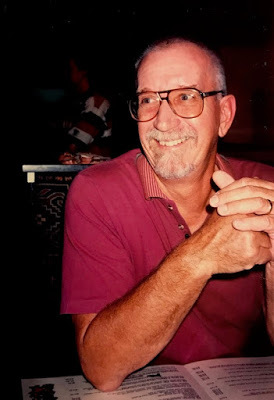 W. GLENN DUNCAN7/13/1940—5/7/2019
W. GLENN DUNCAN7/13/1940—5/7/2019Recently, I received an email from Bill Duncan with the sad news his father, W. Glenn Duncan had passed away after a long struggle with health issues. W. Glenn Duncan was the creator of the iconic Rafferty series of hardboiled private eye novels. The news was particularly poignant for me as I conducted the last published interview with W. Glenn Duncan with the aid of his son, Bill. In the past couple of years, Bill has not only been able to get his father’s six Rafferty books back into print, but has also taken over the Rafferty mantel as he continues the character in books of his own. Bill has also become a friend.
Bill recently sent out an email to the many fans old and new of his father’s writing, stating: I'm so grateful to each and every one of you for the joy you brought to Dad in the last couple of years, as he got to know the true breadth of support for Rafferty and all the other characters he created. I know I've said it before, but I'll never forget that you did that for him. Thank you from the bottom of my heart.
In a wonderful tribute to his father, Bill also wrote the following scene featuring Rafferty and his cohorts as they say their own goodbye to their creator...Personally, it gave me chills...
Sunset.
A secluded location on the shores of Lake Texoma, Texas.
The sun wavered on the horizon across the water. Hung there like it knew its job was to finish setting, but it wanted to give our motley group just a little more light, more warmth, more time before the day ended and the dark times came.
We got the flames going pretty good and pushed the rowboat out. The breeze slapped little wavelets against the wooden topsides for a few seconds, then it grabbed hold of the small boat and its cargo and dragged them quickly away from shore.
Cowboy was the first to break the silence, holding his Stetson in his large hands and running a knobby thumb along the brim. “Well, goddamn,” he said. “Didn’t never expect it would come to this.” He kicked at a rock with his boot. “Goddamn,” he said again.
“Uh huh,” I replied.
Mimi stood tall, all four feet and a bit of her, and blinked back tears. I’d never seen Mimi cry before. “He’s really gone, isn’t he?” she said.
“Fraid so, Mimi,” I said. “I wish like hell he wasn’t but …”
She nodded, ran a finger under both eyes, and hugged herself. Cowboy draped an arm around her shoulders.
Ed Durkee’s brown suit had wilted while we were getting the rowboat ready, and the coming chill of the evening wasn’t going to breathe life back into it. He dry-rubbed his face and sighed. “I can’t believe you talked me into this, Rafferty. A goddamned Viking funeral! If anyone comes down here, I’m gonna pretend like I don’t know what’s going on and I’ll bust you all.”
“You didn’t have to come,” I pointed out. “Relax, Ed. It’ll all be over soon,” I said. “He’ll either make it into Oklahoma or completely burn up. My money’s on burning up. Did you leave any lighter fluid in the can, Ricco?”
Ricco pulled the toothpick from the corner of his mouth, shook his head twice, and grinned.
The flames were really going now, they must have been fifteen, maybe twenty feet high, as the little boat turned in circles, caught in an unseen eddy.
Hilda wrapped an arm around my waist.
“I’m so sorry, Rafferty,” she said in a low voice. “Are you okay?”
Shook my head.
“We’ve known each other for so long, it felt like he’d just always be there. I knew that wouldn’t be the case but, dammit, I wanted it to be.” I looked around the circle of faces, knew that they expected me to say something in the moment.
I toasted the flaming boat with my beer.
“Glenn Duncan. He was the best of all of us. A doer, a man who made things happen. In fact I’m reminded of a quote by Heinlein. It goes something like ‘A man should be able to change...‘“
At that moment something important in the structure of the boat must have burned through because there was an enormous hiss, a cloud of steam, and then nothing.
I looked at the lake surface, ripples fanning out in all directions from where the rowboat and Glenn had slipped beneath the water.
I like to think that those ripples will always be there. They may be small, they may be far away, and they may even be too hard to see with the naked eye, but they will be there.
Always.
I turned from the lake and looked at my friends.
“Hell with it. You guys ready to kick ass and take names?”
Mimi nodded, reached into her oversize purse, and checked her Uzi.
Cowboy slid his hunting knife into the scabbard at the small of his back and said, “Let’s git amongst ‘em.”
Ed shook his head and pretended like he was somewhere else.
Ricco just grinned.
Hilda leaned into me, nestled her head into my chest, and rubbed her hand on my back.
“It’s what he would want,” she whispered.
I nodded.
Damn straight.
In the two posts below you will find the two part interview I conducted with W. Glenn Duncan in 2017...

Published on May 16, 2019 16:34
RAFFERTY DOWN UNDER—PART 1
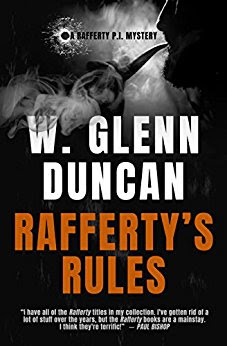
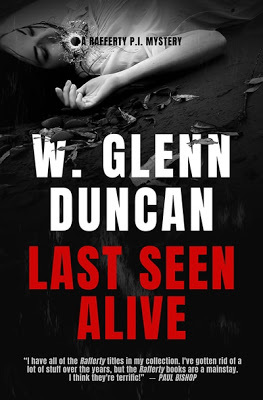
 RAFFERTY DOWN UNDER• PART 1 •
RAFFERTY DOWN UNDER• PART 1 •Somewhere, jockeying for position in my top five favorite tough guy private eyes, you will find the six book Rafferty series by Shamus Award winning author W. Glenn Duncan. Like author John Whitlatch, who I previously posted about, W. Glenn Duncan has been an enigma to his fans for many years. A former journalist and pilot, Duncan lived in Iowa, Ohio, Florida, Texas, and California, before disappearing into the proverbial wilds of Australia with his wife and three children.
Since the 1990 publication of the last Rafferty book, Fatal Sisters, a hardcore cult of mystery fans has grown around the paperback original Rafferty series. Whenever knowledgeable hardboiled gurus talk about favorite, overlooked, or forgotten private eye series, Rafferty is always mentioned at the highest levels.
The Rafferty series has been compared to both Robert B. Parker’s Spenser novels, which began a few years prior to the first Rafferty book, but had not yet become the bestselling phenomenon it is today. Robert Crais’ Elvis Cole premiered the same year as Rafferty’s Rules and also found itself being compared to the Spenser formula. Other series, including Harlan Coben’s Myron Bolitar books, followed a similar pattern.
The Rafferty series, however, broke away from the pack to establish its own original niche in the pantheon of great private eyes. The series became known not only for the spot on philosophy of the frequent quoting of Rafferty’s rules, but also for the great interplay between the tougher than tough Rafferty and his even tougher sidekick, Cowboy. Tougher than both of them, though, is Cowboy’s wife—the delightfully height challenged, Mimi. Each of the Rafferty books had an added depth of social conscious, dealing with problems that are still pertinent today.
Attempts have been made to trace Duncan for interviews or simply to find out more information about the author and his series—all eventually running into a dead end down under. Casual and in-depth Internet searches fail to provide any extensive or definitive information. Most recently, Lee Goldberg’s Brash Books tried to locate Duncan to obtain the reprint rights to the Rafferty series. Those efforts also ran aground on the coast of Austrailia and the search eventually abandoned.
When I wrote my original blog post on the enigmatic John Whitlatch in 2009, it prompted an unexpected response from an individual who had worked with Whitlatch in the insurance industry. When I reached out to the respondent, he provided me with a wealth of information on Whitlatch, which was previously unknown to genre mavens. I wrote and posted an article to document the details, causing a minor Internet run on used copies of Whitlatch’s novels—likely inflating prices by a few bucks for those late to the party.
Recently, I experienced a similar out of the blue response to a blog post I’d written regarding my admiration for the Rafferty series. Bill Duncan, son of W. Glenn Duncan contacted me to ask if he could quote my blog post as he was preparing to relaunch his father’s Rafferty novels in e-book format. The relaunch of the Rafferty series was great news, but I was also excited when Bill told me he was also taking over the reins of the Rafferty series, writing a new adventure—False Gods—which is great news for new readers and long term fans.
Bill graciously agreed to pass some specific questions on to his father related to the Rafferty series, and to also answer some questions himself about the upcoming Rafferty reissues and the soon to be released new Rafferty novel...
******INTERVIEW WITH W. GLEN DUNCAN
What can you tell us about your background, your reading interests, and how you began writing?
I was an avid reader growing up and read anything I could get my hands on. Studied journalism briefly in college before serving in the US Navy. After getting out, I went back to journalism and worked as a radio reporter in Dallas in the first half of the sixties. The whole job was being out and about, talking to and observing people. Dallas was a busy town. There was always something going on. And I had a car and could go anywhere I wanted to get a story. I was like a kid with a doughnut.
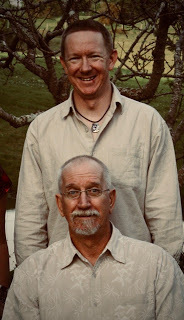 In 1964, I was inside the Neiman-Marcus building as it burned in the famous five-alarm fire, and I was the only reporter there. Everyone else was too chickenshit to come inside. Stanley Marcus, the store’s namesake was there too, and every five minutes he’d jump on the mic to say, “We’ll be open tomorrow morning at 8am for business.”
In 1964, I was inside the Neiman-Marcus building as it burned in the famous five-alarm fire, and I was the only reporter there. Everyone else was too chickenshit to come inside. Stanley Marcus, the store’s namesake was there too, and every five minutes he’d jump on the mic to say, “We’ll be open tomorrow morning at 8am for business.”I learned from that situation that the best thing to do was to get to someone who’s close to the story, and let them tell you the story. There’s an enormous vat of interesting stories in everyday interactions if you’re aware. If your ears are good enough, your pen can be good enough too.
What type of books do you enjoy reading and was there any book in particular that inspired you to begin writing?
No one book in particular inspired me, but I’ve always liked mysteries, adventure and aviation-related stories. Writers I’ve enjoyed reading are Wilbur Smith, John D. Macdonald, Stephen King and Robert B Parker.
Did you do any other writing before the Rafferty series or did you jump right into writing Rafferty’s Rules?
Rafferty was the third full-length novel I’d written. The previous two weren’t published. I did have a handful of short stories published...
It Could Happen to AnybodyMike Shayne
Mystery Magazine
Sept 1983Wally the DumbAlfred Hitchcock’s
Mystery Magazine
April 1984The Gray MercedesMike Shayne
Mystery Magazine
July 1984Alone at SeaAlfred Hitchcock’s
Mystery Magazine
Sept 1984
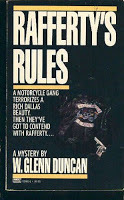 Did you use an agent to sell the Rafferty series or did you go directly over the transom to the publisher?
Did you use an agent to sell the Rafferty series or did you go directly over the transom to the publisher?Used an agent. Weirdly, though, it was an agent I hadn’t queried. I received a note from an intern, or assistant, who’d pulled Rafferty out of the slush pile at the agency where she worked and read it in her own time. She got in touch and told me the manuscript wouldn’t go anywhere at her agency, but she enjoyed it. However, she also thought it was the type of thing another agent she knew was looking for, and suggested I contact him.
Did you plan for Rafferty to become a series character or did you write Rafferty’s Rules as a standalone and the publisher asked for more?
Rafferty was written originally as a standalone, but it was a helluva lot of fun seeing where the characters took me in the subsequent books.
The Rafferty books were some of the last titles to be published under Fawcett’s iconic Gold Medal imprint. Were you aware of the storied Gold Medal history when you were being published by them?
Not really.
Did Gold Medal contract for the full series or go from book to book?
They took Rafferty’s Rulesfirst, then did a two-book deal for Last Seen Alive and Poor Dead Cricket, then a three-book deal for Wrong Place, Wrong Time, Cannon’s Mouth, and Fatal Sisters.
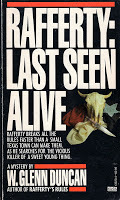 Did the Gold Medal choose not to continue the series after Fatal Sisters (Rafferty #6) or did you choose not to continue because of other demands on your time?
Did the Gold Medal choose not to continue the series after Fatal Sisters (Rafferty #6) or did you choose not to continue because of other demands on your time?When I finished writing Fatal Sisters, I had written six books in four years and I was ready for a break. Fawcett had also refused any new Rafferty stories due to declining sales, so I decided to take some well-earned down time.
My youngest daughter had moved out of the house, Val and I were enjoying being kid-free again, and my passion for sailing had grown to the point where I was refitting sailing boats and we were taking months-long cruises up and down the East Coast of Australia. By the time I was ready to get stuck back into Rafferty, the movie had been released. I was so disappointed with what they’d done, I decided to stop there and then. I always believed when it stops being fun, it’s time to stop. And it was.
Were you surprised to win the Shamus Award for Rafferty’s Rules?
Yes, very. And flattered.
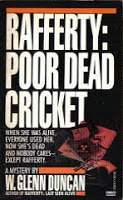 Did you socialize with other writers’ groups such as Mystery Writers of America or Private Eye Writers of America?
Did you socialize with other writers’ groups such as Mystery Writers of America or Private Eye Writers of America?No. This was the mid to late eighties, and Australia might has well have been on another planet, as far as communication was concerned. All correspondence between the agent and me was still by typewritten letter!
How did Rafferty’s Rules come to be sold as the basis for the Lorenzo Lamas action film, Snake Eater III—His Law?
The film production company expressed interest in securing a film option to Rafferty’s Rules in the late eighties. ’88, ’89, somewhere around there. I don’t remember if they approached my agent or if it was the other way around. It took forever to reach an agreement on the contract. With 20/20 hindsight, maybe I should have known it would turn out the way it did.
The production company originally said that they wouldn’t use Rafferty’s Rules as the basis for a Snake Eater film, but in ’91 they exercised their option and, unfortunately, we all know what happened afterward.
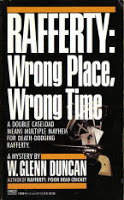 Did you have any other involvement in making the movie?
Did you have any other involvement in making the movie?Hell, no. Does it look like it? I sincerely hope not. Truth be told, although I’ve always been a proponent of the “Take the money and run” approach for Hollywood enquiries, the complete disaster the movie became is a solid argument for getting involved.
A lack of information from my agent on exactly how the story would be used also factored into my hands-off approach. If I’d known how much they were going to screw it up, I would have fought for Rafferty.
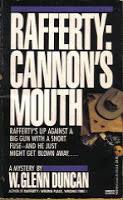 What prompted you to move to Australia and was the move before, after, or in the middle of writing the Rafferty books?
What prompted you to move to Australia and was the move before, after, or in the middle of writing the Rafferty books?We moved to Australia in 1975 after watching the debacle that the US government had become with Nixon and the Watergate affair. We wanted to give the kids a better place to grow up and Australia reminded us a lot of the way the US used to be.
Were you ever aware genre fans and publishers were trying to track you down?
Honestly had no idea until Bill told me what he’d found in speaking to you and a few of the other contacts he’d made. We’d been living aboard a boat for 15 years too, mostly away from any sort of public life and far, far away from the internet. The whole idea of social media (what the hell is that, anyway?) and having an online “presence” bores me to tears.
Have you continued to write while down under?
After Rafferty finished, I wrote a few articles for boating magazines.
Have you read any of the Australian crime writers?
I enjoy both Peter Corris and Jon Cleary.
How do you feel about Rafferty making a comeback under the guidance of your son, Bill?
I think it’s great that Bill is repubbing my books, and it’s hard to believe there are still people out there who want to read those old things, but the most exciting part is to know that Bill is writing his own instalment. Really looking forward to the release of False Gods.
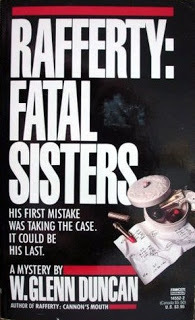 Why does Rafferty remains a cult favorite among hardboiled fans?
Why does Rafferty remains a cult favorite among hardboiled fans?Wow, I really don’t know. All I can say is that I had a helluva lot of fun writing each story and I guess that probably comes through in the reading. It surprises me that they seem to have stood the test of time, but I believe it’s all down to the relatability of the characters, which was the easy part. Once I got started, the characters and the situations they found themselves in would tell me what they wanted to do next. I just let them be themselves and didn’t force them anywhere.
Cowboy and Mimi were my favorites. Nobody had ever written a couple like that before and I thought it would be fun to see what happened with them. It was. And though mysteries and crime are easy to make plot-driven, I always wanted the characters to be the central focus. There’s no point in telling the reader what happens next when I can show them by making the characters do things that move the action along.
You’ve got to keep the reader interested, and I hope the stories did that. In Last Seen Alive, where Boat blows up (Ed: Spoiler alert) there was no reason to have Jim Belker and his daughter in the scene. But by including the realistic scenario of a father and daughter on a quiet fishing trip nearby, I could increase the drama and tension and get the reader more invested in what’s happening.
******Thanks to W. Glenn Duncan for the great conversation. In Part 2 of Rafferty Down Under, it’s time to bring Bill Duncan under the interrogation lamps and tell us about the bright future planned for the Rafferty series.
TO VISIT THE
RAFFERTY P. I. WEBSITE
CLICK HERE
TO LEARN MORE ABOUT THE RAFFERTY SERIESON THE THRILLING DETECTIVE WEBSITE CLICK HERE
THE RAFFERTY SERIESRafferty's Rules (1987)Last Seen Alive (1987)Poor Dead Cricket (1988)Wrong Place, Wrong Time (1989)Cannon's Mouth (1990)Fatal Sisters (1990)
COMING SOONFalse Gods (2018)RAFFERTY AND THE MOVIESIn 1989, looking to capitalize on his martial arts skills, pretty boy Lorenzo Lamas tried to make the jump from a secondary character on the television prime time soap opera Falcon Crest, to big screen action movie star. Unfortunately, his choice for his first action role was the disasterous low budget B-movie, Snake Eater. The plot played out like an entry in a by-the-numbers men’s adventure paperback series. As Jack Soldier Kelly, Lorenzo Lamas is the leader of the Snake Eaters, an elite division of the Marines especially trained for search and destroy missions. When Soldier finds out a band of backwoods bad-guys have killed his parents and abducted his sister, he returns home to extract kick-ass revenge.
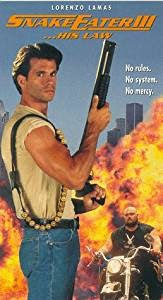 Somehow, Snake Eater spawned two sequels. Snake Eater II—The Drug Busterdid a hit and run on the big screen in 1989, almost immediately after the release of the original. In 1992, Snake Eater III—His Law completed the trilogy. There is one remarkable thing about Snake Eater III. While the first two Snake Eater entries were original screenplays, Snake Eater III was based on W. Glen Duncan’s novel Rafferty’s Rules—the first in his Rafferty series.
Somehow, Snake Eater spawned two sequels. Snake Eater II—The Drug Busterdid a hit and run on the big screen in 1989, almost immediately after the release of the original. In 1992, Snake Eater III—His Law completed the trilogy. There is one remarkable thing about Snake Eater III. While the first two Snake Eater entries were original screenplays, Snake Eater III was based on W. Glen Duncan’s novel Rafferty’s Rules—the first in his Rafferty series.From a glance at its synopsis, Snake Eater III—His Law would appear to follow at least the basic set-up of Rafferty’s Rules...Vietnam vet Jack Soldier Kelly is hired to find a biker gang called Hell's Fury and extract revenge on the outlaw bikers for the kidnapping, drugging, and rape of a young college co-ed. Even Rafferty’s partner in crime, the slightly psychotic Cowboy (portrayed by stunt coordinator Minor Mustain), gets name checked as an ex-biker turned private eye who teams up with Soldier.
Soldier even gets Rafferty’s love interest, Hildy Gardener (Canadian actress Tracey Cook). However, beyond a couple of well-choreographed martial arts scenes, the movie did the source material no favors.
Published on May 16, 2019 16:29
RAFFERTY DOWN UNDER—PART 2
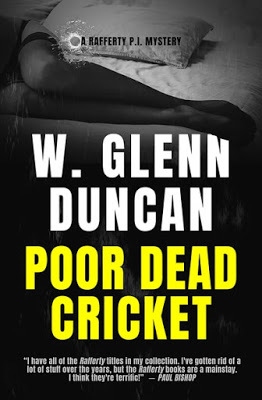
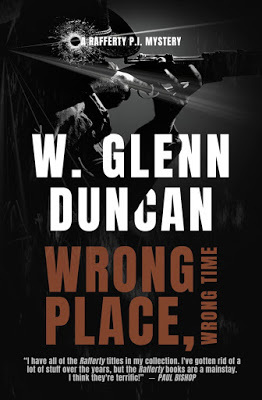
 RAFFERTY DOWN UNDER PART 2INTERVIEW WITH BILL DUNCAN
RAFFERTY DOWN UNDER PART 2INTERVIEW WITH BILL DUNCANIn Part 1 of Rafferty Down Under the illusive authorial fugitive W. Glenn Duncan was finally tracked down and brought in for questioning about his cult favorite private eye, Rafferty. Along the way we learned W. Glenn Duncan’s son, Bill Duncan, is not only republishing the original series of Rafferty novels, but has been writing Rafferty novels of his own, which are set to appear in 2018. Now it’s Bill’s turn under the bright lights of the interrogation room…
********Can you give us a brief biographical sketch of Bill Duncan?
Well, I was born at a very early age. Okay, that’s my one joke out of the way, and I promise to not to make any more. Maybe. Our family moved to Australia from the States when I was seven and I just did the usual kid things on both sides of the Pacific. Once here, we bounced around every couple of years—Mum and Dad always said they were gypsies at heart—even living on a farm for a few years.
 After school I went to University and graduated with degrees in Architecture. Spent the next 20 odd years working my way through various roles in the construction industry, and believe me, some of them were odd. I never really felt like I fit in anywhere. Maybe it was the writer bubbling away underneath trying to tell me something, maybe the gypsy genes, maybe a combination of both. Got married early, though the marriage didn’t last, and have two wonderful adult kids now.
After school I went to University and graduated with degrees in Architecture. Spent the next 20 odd years working my way through various roles in the construction industry, and believe me, some of them were odd. I never really felt like I fit in anywhere. Maybe it was the writer bubbling away underneath trying to tell me something, maybe the gypsy genes, maybe a combination of both. Got married early, though the marriage didn’t last, and have two wonderful adult kids now.Three truths and a lie about me:
At six months old, I had travelled more miles by air than by car.
Member of Mensa.
Have never fired a gun.
Once crashed a car into the top story of a two story house.
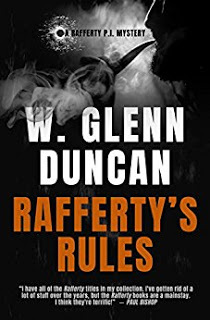 Were you a reader growing up? If so, what books did you enjoy?
Were you a reader growing up? If so, what books did you enjoy?Yeah, definitely. I read very early and Mum and Dad still love telling the story about me throwing my kindergarten teacher for a loop, resulting in them being called down to the school to be admonished, “You didn’t tell us he was a reader.”
I wish I had a great story about devouring The Collected Works of Tolkien by the time I was eight, and it being my springboard into the heady realms of writerdom but the truth is my tastes weren’t that exotic. As a young boy, I was drawn to true-life adventure—explorers, early pilots crossing oceans and undiscovered lands—that kind of thing. The first fiction I remember reading was a Hardy Boys book, and it lit a fire inside me. I devoured the series and loved every one of them.
Later on my reading spanned a few genres, mostly led by Dad’s reading tastes. Memorable reads from those times were Brian Lecomber’s work, Tales of the Black Widowers by Asimov, and Heinlein’s Tunnel in the Sky. There’s definitely a thread of adventure there, but what impacted me most was the humanity of the characters. What would they do? Why are they doing it? How far will a person go when pushed?
When did you realize your dad had written this series of cool detective books?
I was in high school when Dad retired from being a commercial pilot and turned his hand to writing. I remember the early days of him pounding away at the typewriter, but mainly I was trying to work out how I felt about being the only kid I knew whose father had a commercial photocopier at home. This is the eighties, remember.
I read a couple of the short stories he had published in AHMM and Mike Shayne and the first novel (non-Rafferty and unpublished) he wrote, and I remember the day when he told me Ballantine picked up Rafferty’s Rules. I was away at University when it was released so, though I knew what he was doing, I wasn’t close to it at the time. I was always proud to be able to tell my friends about my father, the published author, but I didn’t really understand the reach or the impact of the books until much later.
Did you read them immediately or did you rediscover them again later?
I read each book as they were released and have come back to them time and time again—as I tend to do with books I enjoy. Which probably explains why my TBR pile is still too tall for me to jump over.
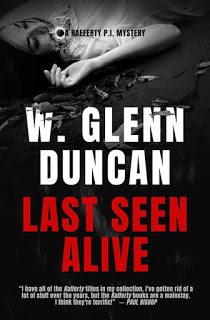 How did your dad feel about the Rafferty books?
How did your dad feel about the Rafferty books?I know he really enjoyed writing them—both the process and the result—but felt badly let down by the movie adaptation of Rafferty’s Rules. Having seen it, I have to agree with him. Dad has always been the kind of guy who would decide he was going to do something, and then just go get it done. I’m not sure if he realizes how big a deal it was to pick up writing as a new career and see the success his books had, but it’s been a huge inspiration to me as I look to follow a similar path.
When and why did you decide to revitalize the Rafferty books?
That decision was made in late 2016, after I’d already completed the first draft and a major rewrite of False Gods, and went hand in hand with my decision to indie publish. My original intention was to head down the traditional publishing route, and to target Dad’s old agent with my first query when the MS was ready.
In the end, what pushed me down the indie path was finding the online reactions to Rafferty, from people like you, Kevin Burton Smith, Bill Crider and Cliff Fausset. I knew from the words, and the obvious passion for the books, there was a market out there. I also realised it was unlikely a publishing house would be able to stop looking for the next ’69 Shades of the Girl with the Salamander Tattoo Gone on the Train’ blockbuster long enough to resurrect a few old PI books languishing on their backlist.
I figured, too, if there were fans from 30(!) years ago, then there were likely new fans who hadn’t caught up with Rafferty the first time around. So, Dad and I discussed the idea of revitalizing his books and he gave me the go ahead.
To test my theory about the publishing house, I floated a trial balloon past Ballantine, and Dad’s old agency, by approaching them for a rights reversion of Dad’s books, and telling them what I was planning to do. Neither of them blinked, they issued the reversion, and it saved me the hassle of writing a query letter.
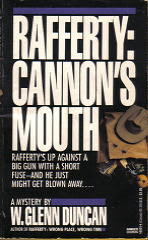 When did you make the decision to write a new Rafferty adventure?
When did you make the decision to write a new Rafferty adventure?In 2014, I suffered a deep bout of depression with the end result being I had to walk away from my previous career and business. As I was starting to come out the other side of the black cloud, I spent a lot of time thinking about how I could reinvent myself in a more sustainable way. I’d always been drawn to writing and dabbled with it from time to time—starting a novel and never carrying on with it, writing non-fiction pieces for business, and similar things—and long dreamed of writing full-time, but had never followed through.
At the same time, and probably because of where I was mentally, I thought a lot about legacy. In particular, what happens to the intangibles when we’re no longer here. Like Dad’s Rafferty books. It seemed a helluva shame all the work he’d done and the magic of his creation might just disappear with his passing. It didn’t seem fair and I decided to do what I could to make sure it didn’t happen.
In 2015, with those two things in mind, I knew this was my chance to see if I could do the work necessary to become a writer and I needed get my ass in gear and give it my best. Six months later I had completed first drafts of two 100,000 word novels. The second of those was False Gods.
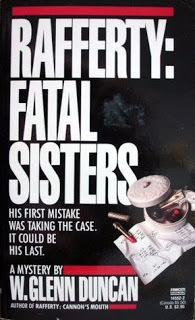 How did your discussion with your dad go when you said you wanted to continue his Rafferty series with the new novel False Gods?
How did your discussion with your dad go when you said you wanted to continue his Rafferty series with the new novel False Gods?He was really supportive, but tempered his enthusiasm with cautionary tales of the author as income-producing business. As far as the opportunity for Rafferty to hit the streets once again, he gave me carte blanche to do anything I wanted with the settings and the characters—move Rafferty to Australia, bring him into the 2000s, or anything I wanted to do.
I think he saw this as a way to make the new stories easier to write. However, one of the appeals of Rafferty has always been the voice of the time and place. I’m also an unabashed child of the 80s, so Rafferty remains—and will remain—a Dallas P.I. firmly rooted in the late 20th century.
Did your dad have any notes, partial manuscripts, or other story fragments for other Rafferty books?
There are no unpublished works. Mum and Dad moved several times since the nineties, so there weren’t even notes or compendiums for the published books. I rebuilt each one by scanning the actual mass-market paperbacks and compiling them from scratch. This process allowed me to get into the timelines of all the stories, confirm Rafferty’s rules (and their somewhat random numerical basis), the weapons he owns, and a bunch of other details. It was a great way for me to really inhabit Rafferty’s world, which I hope gives depth to the new books.
Have you written other fiction before Rafferty: False Gods?
I’ve written bits and pieces over the years, but the only fiction I’d ever finished was the first of those two novels I mentioned. It’s a book called Finding Karol and the archetypal first novel: highly cathartic, strived-for literary fiction, and self-compared to Jodi Picoult and Paul Theroux. It got some traction with Australian agents, but didn’t get across the line to a deal, and is currently in hiding on my hard drive.
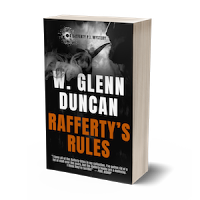 How did you learn the process to republish the Rafferty books?
How did you learn the process to republish the Rafferty books?Standing on the shoulders of giants was, and remains, the key. When I first started looking into the idea of indie publishing, I stumbled upon the writer/marketing site of Joanna Penn, which led me to the similar sites of Nick Stephenson and Mark Dawson. The three of them, and their generosity in sharing the lessons they’ve learned over years of trial-and-error, gave me the confidence I could make this work, and a lot of the blueprints to follow.
Your marketing plan is an example of doing things right. Do you have a background in marketing or learn on the fly?
Thanks for saying so. Obviously, I’ve got you fooled. It’s still very early days, but I feel like I’m on the right track. I’ve no formal background in marketing, so it really is learning on the fly. There’s a huge wealth of experience and opinions out there, with easier access than ever before. Not everything will work for everyone, so it’s important to assess with a critical eye and implement what seems to be the right thing for you and what you want to get out of your marketing. And if it doesn’t work the way you hoped, change until it does.
If you are flying by the seat of your pants in the publishing world (like many of us) what lessons have you learned from your experiences?
There’s a few...
Trust your gut— I knew that there was a new life for Rafferty and that the stories would resonate with, and entertain, both existing and new fans. The feedback I’ve already had has proven this was the right call.
Stick to your values— I’m pretty pedantic. Bill’s Rule #1: Any job worth doing is worth overdoing. Levity aside, making your work the best it can be is the writer’s side of the contract with readers. Great covers, professional editing, and thorough research is every bit as important as good storytelling.
It’s not life or death— Notwithstanding the above, it’s easy to get bound up in trying to make everything perfect. It never will be. Neither will any minor error be a catastrophic disaster that stops you dead. Do the best you can with what you have to hand at the time, move on, and try to do a little better tomorrow.
This is the best time in history to be a writer— We have access to unprecedented technology allowing us, as individuals, to run global businesses with a laptop and an internet connection. The barriers to entry have never been lower, so grab the opportunity with both hands and run like hell.
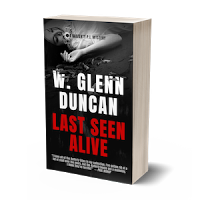 What’s the next case for Rafferty?
What’s the next case for Rafferty?False Gods will be out in 2018. I’ve already drafted book #8, with the working title of Blood Angels—however, I’m a little concerned about the repetitive religious language so the title may change. I’m currently working through the manuscript edits. At this point, I’m aiming to also release it in 2018.
Down the track, I’ll also being playing with different versions of all the books—paperbacks, audiobooks, boxsets, and who knows what else. Beyond that point, I’ve got nearly a dozen written what ifs ready to be explored, and I’m sure many more will emerge out of the ether. Whether they all grow in to full Rafferty books is yet to be seen, but I won’t know until I pitch myself into their rabbit-holes. February 2018 is my due date to pull one out of the pile and get started on a new exploration and see where it takes me.
What I do know is that I’ve had an absolute ball on the journey so far. It’s been a great thing for Dad too, to finally get to see the impact of his books on readers, something that wasn’t available to him during his run with the traditional publishing industry. So, I’m up for continuing the ride, if you are. Jump in and ride shotgun with me in this rusted, duct-taped, ’67 Mustang and let’s hit the streets.
*****
Thanks to W. Glenn Duncan and Bill Duncan for making the effort and taking the time to answer some long held questions about the Rafferty series and to fill us in on plans for Rafferty’s future...
TO VISIT THE
RAFFERTY P. I. WEBSITE
CLICK HERE
TO LEARN MORE ABOUT THE RAFFERTY SERIES ON THE THRILLING DETECTIVE WEBSITE CLICK HERE
THE RAFFERTY SERIESRafferty's Rules (1987)Last Seen Alive (1987)Poor Dead Cricket (1988)Wrong Place, Wrong Time (1989)Cannon's Mouth (1990)Fatal Sisters (1990)COMING SOONFalse Gods (2018)

Published on May 16, 2019 16:27
March 5, 2019
MEN'S ADVENTURE—HATCHET
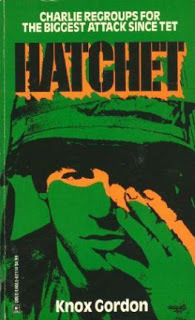
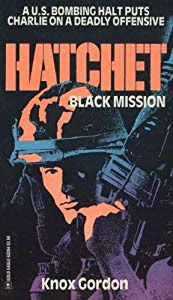 HATCHETBeyond the infantry jungle beating, air bombing and navel shelling, the secret war in Vietnam is fought by Mobil Strike Force Units—Hatchet forces like Captain Mike Reese’s A-410 unit. The specially trained and equipped ready-reaction force handles cross-border missions too dangerous and too clandestine for normal channels...In the air and on the ground, behind the desks and in the jungles, Hatchet is the most action-packed series of the Vietnam War...
HATCHETBeyond the infantry jungle beating, air bombing and navel shelling, the secret war in Vietnam is fought by Mobil Strike Force Units—Hatchet forces like Captain Mike Reese’s A-410 unit. The specially trained and equipped ready-reaction force handles cross-border missions too dangerous and too clandestine for normal channels...In the air and on the ground, behind the desks and in the jungles, Hatchet is the most action-packed series of the Vietnam War...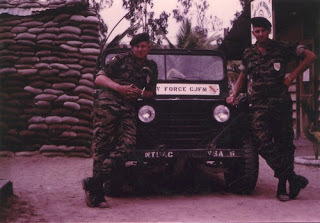 Michael Kasner, the author behind the pseudonym Gordon Knox, was a prolific presence in the men’s adventure genre. His fifty novels included twenty entries in the Stony Man series, two in the Executioner series, and three Super Bolan novels, all written under house pseudonyms. He also wrote the four book Warkeep 2030 series and the three book Black Ops series under his own name.
Michael Kasner, the author behind the pseudonym Gordon Knox, was a prolific presence in the men’s adventure genre. His fifty novels included twenty entries in the Stony Man series, two in the Executioner series, and three Super Bolan novels, all written under house pseudonyms. He also wrote the four book Warkeep 2030 series and the three book Black Ops series under his own name. Kasner served two combat tours in Vietnam. During the Vietnam War, Michael commanded a rapid-reaction platoon consisting of Nung Chinese mercenaries. On his second tour he had a scout platoon on dirt bikes. He was haunted by combat deaths under his command. He was in Da Nang during the Tet Offensive. After leaving the Army, he got a master's degree in art history from the University of Oregon, writing his thesis on military art. All of this added much realism to his action novels. He passed away in 2012...
HATCHET
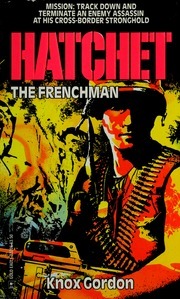 HATCHET #1Year of the Green Beret—Ariel intel indicates a major enemy buildup in the Parrot’s Beak region of Cambodia, which has long been an important staging area into South Vietnam. Ordered to recon the area, a hard-hitting Hatchet Force gets a taste of the covert game played by the SOG boys...The squad’s commander, U.S. Army Special Forces Captain Mike Reese, puts the operation together from the base while combat veteran Lieutenant Jack Santelli and his team hit the field, testing their true abilities as jungle fighters deep in Indian country...With the ferocity and magnitude of the Tet offensive still fresh in their minds, Reese and Santelli know they are dealing with an enemy who has nothing to lose. That’s fine with Reese: Secrecy and surprise can only work once. With undeniable evidence of VC presence, his Hatchet team has got the edge.
HATCHET #1Year of the Green Beret—Ariel intel indicates a major enemy buildup in the Parrot’s Beak region of Cambodia, which has long been an important staging area into South Vietnam. Ordered to recon the area, a hard-hitting Hatchet Force gets a taste of the covert game played by the SOG boys...The squad’s commander, U.S. Army Special Forces Captain Mike Reese, puts the operation together from the base while combat veteran Lieutenant Jack Santelli and his team hit the field, testing their true abilities as jungle fighters deep in Indian country...With the ferocity and magnitude of the Tet offensive still fresh in their minds, Reese and Santelli know they are dealing with an enemy who has nothing to lose. That’s fine with Reese: Secrecy and surprise can only work once. With undeniable evidence of VC presence, his Hatchet team has got the edge. 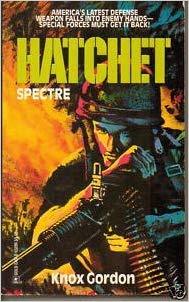 HATCHET #2: SPECTREAn experimental C-130 Spectre aircraft is shot down over Laos by a lurking MiG-21. The U.S. "Spooky" gunship is loaded with super-secret gear and must stay out of enemy hands at all costs. Special Forces Captain Mike Reese and his Hatchet team are ordered to locate the wreckage site and destroy the sensitive electronics package. But the greatest of all military truisms—no plan ever survives initial contact with the enemy—holds fast when the enemy grab the goodies first. Plus it looks like the Russians are involved. When Reese’ request to pursue is refused, he realizes there is only one option: Recover the mission hardware any way he can—even if it means court-martial...
HATCHET #2: SPECTREAn experimental C-130 Spectre aircraft is shot down over Laos by a lurking MiG-21. The U.S. "Spooky" gunship is loaded with super-secret gear and must stay out of enemy hands at all costs. Special Forces Captain Mike Reese and his Hatchet team are ordered to locate the wreckage site and destroy the sensitive electronics package. But the greatest of all military truisms—no plan ever survives initial contact with the enemy—holds fast when the enemy grab the goodies first. Plus it looks like the Russians are involved. When Reese’ request to pursue is refused, he realizes there is only one option: Recover the mission hardware any way he can—even if it means court-martial... 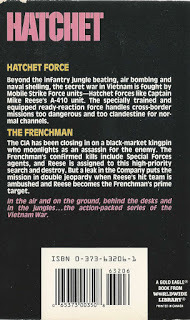 HATCHET #3: THE FRENCHMANThe CIA has been closing in on a black-market kingpin who moonlights as an assassin for the enemy. The Frenchman’s confirmed kills include Special Forces agents, and Reese is assigned to this high priority search and destroy. But a leak in the Company puts the mission in double jeopardy when Reese’s hit team is ambushed and Reese becomes the Frenchman’s prime target...
HATCHET #3: THE FRENCHMANThe CIA has been closing in on a black-market kingpin who moonlights as an assassin for the enemy. The Frenchman’s confirmed kills include Special Forces agents, and Reese is assigned to this high priority search and destroy. But a leak in the Company puts the mission in double jeopardy when Reese’s hit team is ambushed and Reese becomes the Frenchman’s prime target...HATCHET #4: BLACK MISSIONA halt in U.S. bomb raids on North Vietnam allows the NVA and Viet Cong to regroup and launch a deadly offensive.
Published on March 05, 2019 14:18
February 23, 2019
AT THE MOVIES ~ ALITA: BATTLE ANGEL
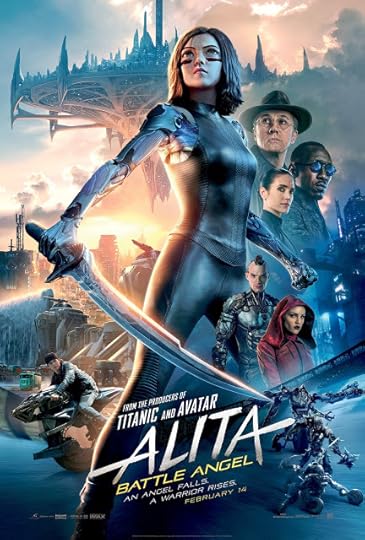 ALITA—BATTLE ANGELIn the 26th century, Dr. Dyson Ido is Iron City’s best doctor and renowned for his ability to rebuild people by meshing them with improvised machined parts savaged from scrap yards. Discovering the remains of an outdated female cyborg with signs of brain activity, Ido rebuilds her with a body designed for his deceased daughter. He names the cyborg Alita when it turns out she has no memory of who she is or where she’s from. When Dr. Ido realizes the young woman in the salvaged cyborg has an extraordinary past and the promise of an even more extraordinary, if violent (very violent) future for which she is unprepared complications ensue.
ALITA—BATTLE ANGELIn the 26th century, Dr. Dyson Ido is Iron City’s best doctor and renowned for his ability to rebuild people by meshing them with improvised machined parts savaged from scrap yards. Discovering the remains of an outdated female cyborg with signs of brain activity, Ido rebuilds her with a body designed for his deceased daughter. He names the cyborg Alita when it turns out she has no memory of who she is or where she’s from. When Dr. Ido realizes the young woman in the salvaged cyborg has an extraordinary past and the promise of an even more extraordinary, if violent (very violent) future for which she is unprepared complications ensue. 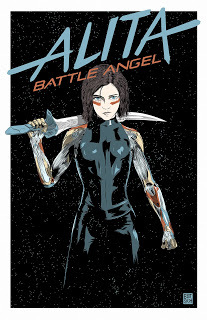 Alita—Battle Angel reminds me in many ways of Ready Player One. Both films brilliantly present a complex story in a way understandable to neophytes, but multifaceted enough to still engage those intimately familiar with the world being presented. Where Ready Player One accomplished this feat under the genius directorial guidance of Stephen Spielberg, Alita—Battle Angelsucceeds through the genius writing and producing skills of the equally gifted James Cameron.
Alita—Battle Angel reminds me in many ways of Ready Player One. Both films brilliantly present a complex story in a way understandable to neophytes, but multifaceted enough to still engage those intimately familiar with the world being presented. Where Ready Player One accomplished this feat under the genius directorial guidance of Stephen Spielberg, Alita—Battle Angelsucceeds through the genius writing and producing skills of the equally gifted James Cameron.  A cyberpunk epic, Alita is based on a popular dystopian manga (stylized Japanese graphic novels) by Yukito Kishiro, which is a mash-up of Rollerball, Robotech, and Transformers. What makes Alita different and worthy of attention is it has a heart, a girl warrior—the titular Alita—who is all human despite her almost entirely cyborg body.
A cyberpunk epic, Alita is based on a popular dystopian manga (stylized Japanese graphic novels) by Yukito Kishiro, which is a mash-up of Rollerball, Robotech, and Transformers. What makes Alita different and worthy of attention is it has a heart, a girl warrior—the titular Alita—who is all human despite her almost entirely cyborg body.  The film effortlessly captures this human element along with pitch-perfect pacing, fantastic motion capture techniques, outstanding visual effects that go beyond the high-tech CGI, seamlessly choreographed action, a clicked in soundtrack, a solid story, committed acting by Rosa Salazar as Alita and Christopher Waltz as her father figure Dr. Ido, and inspired direction on the part of Robert Rodriquez.
The film effortlessly captures this human element along with pitch-perfect pacing, fantastic motion capture techniques, outstanding visual effects that go beyond the high-tech CGI, seamlessly choreographed action, a clicked in soundtrack, a solid story, committed acting by Rosa Salazar as Alita and Christopher Waltz as her father figure Dr. Ido, and inspired direction on the part of Robert Rodriquez. Overall, Alita—Battle Angel is gorgeous, entertaining, and a special effects spectacle. Be prepared to let your popcorn get cold when you get caught up in the story despite never having read a magna in order to understand why Alita’s eyes are so stylized and big.
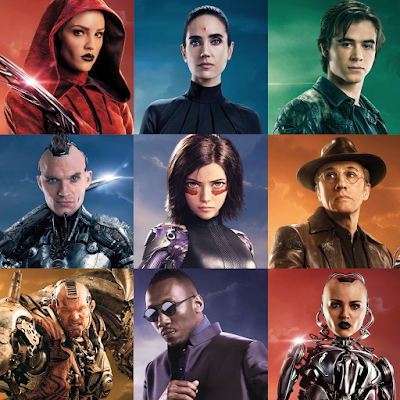
Published on February 23, 2019 22:13
AT THE MOVIES ~ ISN'T IT ROMANTIC
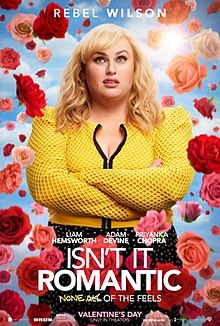 ISN’T IT ROMANTICIf you are not a Rebel Wilson fan this movie is not for you. Wilson is a comedian who knows her shtick and is shticking to it. If you find Wilson funny, you’ll quickly realize this is the perfect movie for her. Its premise takes advantage of all her comedic skills and then some—who knew she could sing and dance—and she effortlessly carries the entire film on her very wide shoulders.
ISN’T IT ROMANTICIf you are not a Rebel Wilson fan this movie is not for you. Wilson is a comedian who knows her shtick and is shticking to it. If you find Wilson funny, you’ll quickly realize this is the perfect movie for her. Its premise takes advantage of all her comedic skills and then some—who knew she could sing and dance—and she effortlessly carries the entire film on her very wide shoulders.Wilson plays Natalie, her usual smart, but cynical character who this time out despises everything about movies billed as romantic comedies, aka rom-coms. Living in a rundown apartment with an unaffectionate dog, she’s an architect who nobody takes as more than competent—good for designing parking structures, but not much else. She finds herself being taken seriously by her co-workers, and even has a tough time reining in her assistant who watches romantic comedies on her computer all day at work.
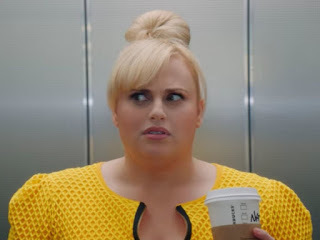 Mugged in the subway on her way home, Natalie hits her head and wakes up trapped in a new reality where she is the center of attention for all the hearts, flowers, and sappy characters she despises in every rom-com ever made. Satire is hard to define and even harder to pull off. Isn’t It Romantic tries hard to satirize every rom-com movie cliché and almost succeeds to rise to that level. The one minor problem is the film is very meta and blunts it’s satiric edge by eventually becoming a traditional rom-com in and of itself. However, this is not necessarily a criticism. I came out of the theater feeling upbeat and entertained, which is the whole point of why I go to the movies.
Mugged in the subway on her way home, Natalie hits her head and wakes up trapped in a new reality where she is the center of attention for all the hearts, flowers, and sappy characters she despises in every rom-com ever made. Satire is hard to define and even harder to pull off. Isn’t It Romantic tries hard to satirize every rom-com movie cliché and almost succeeds to rise to that level. The one minor problem is the film is very meta and blunts it’s satiric edge by eventually becoming a traditional rom-com in and of itself. However, this is not necessarily a criticism. I came out of the theater feeling upbeat and entertained, which is the whole point of why I go to the movies. 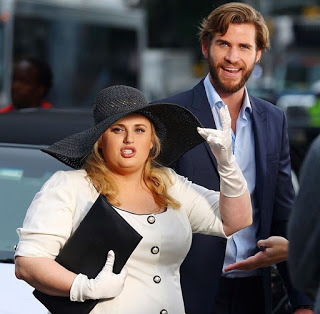 If I do have a criticism, it’s the handling of the rom-com girl’s traditional gay sidekick. The character is so over the top as to be insulting. The jarring characterization fails to blend with the low-key performances of the other actors, who are all there to support Wilson and not to stand out in the crowd. Particular kudos to Liam Hemsworth, as the satirized romantic lead, who charmingly walks the tightrope between character and characterization with aplomb.
If I do have a criticism, it’s the handling of the rom-com girl’s traditional gay sidekick. The character is so over the top as to be insulting. The jarring characterization fails to blend with the low-key performances of the other actors, who are all there to support Wilson and not to stand out in the crowd. Particular kudos to Liam Hemsworth, as the satirized romantic lead, who charmingly walks the tightrope between character and characterization with aplomb. 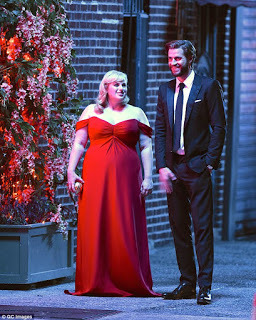 I was not at all disappointed Isn’t It Romantic choose to step lightly on its satiric intentions, and didn’t go down the dark rabbit hole of a more scathing approach. The rabbit hole may have been a more critically interesting trip, but for lightweight comedic fluff, Isn’t It Romantic is clever enough to keep you chuckling, and even made me laugh out loud several times. The coup de grâce, however, is the closing Indian cinema inspired dance routine. It’s a hoot and a great way to give a rousing end to the film, which otherwise might have ended on a flat note. If you are looking for a clever date night movie with a bit of bite, then go see Isn’t It Romantic strictly for what it is—light, funny, and a highly commercial vehicle for the talents of Rebel Wilson.
I was not at all disappointed Isn’t It Romantic choose to step lightly on its satiric intentions, and didn’t go down the dark rabbit hole of a more scathing approach. The rabbit hole may have been a more critically interesting trip, but for lightweight comedic fluff, Isn’t It Romantic is clever enough to keep you chuckling, and even made me laugh out loud several times. The coup de grâce, however, is the closing Indian cinema inspired dance routine. It’s a hoot and a great way to give a rousing end to the film, which otherwise might have ended on a flat note. If you are looking for a clever date night movie with a bit of bite, then go see Isn’t It Romantic strictly for what it is—light, funny, and a highly commercial vehicle for the talents of Rebel Wilson. 
Published on February 23, 2019 16:40
THE RUSSIANS ARE COMING ~ IRREDEEMABLES
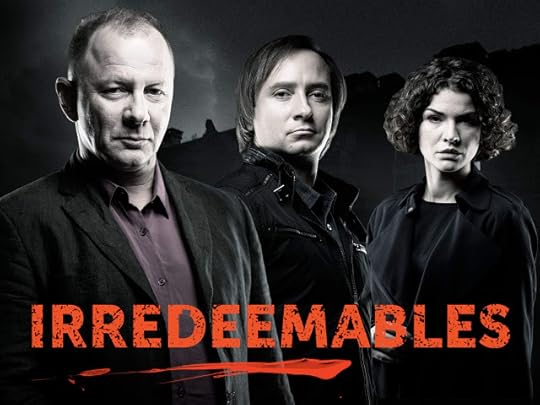 IRREDEEMABLESWho can investigate impossible to solve criminal case better than convicted felons? Police colonel Stadnik has always dreamt of repeating the 19th century experiment of the legendary French detective Eugène Vidocq, who formed the most effective investigative division in Paris exclusively from the ranks of prisoners. Once he gets his chance, Stadnik creates a special unit within his own department...A sentenced criminologists with shady past, a female ex-police detective who murdered the killer of her daughter, and a male ex-police detective convicted of corruption, who must solve the most complicated cases in order to get back their jobs and their freedom...
IRREDEEMABLESWho can investigate impossible to solve criminal case better than convicted felons? Police colonel Stadnik has always dreamt of repeating the 19th century experiment of the legendary French detective Eugène Vidocq, who formed the most effective investigative division in Paris exclusively from the ranks of prisoners. Once he gets his chance, Stadnik creates a special unit within his own department...A sentenced criminologists with shady past, a female ex-police detective who murdered the killer of her daughter, and a male ex-police detective convicted of corruption, who must solve the most complicated cases in order to get back their jobs and their freedom... The Russian TV cop shows I’ve watched via Amazon Prime are almost perfect clones of their American and British counterparts. There is nothing new, not even anything specifically Russian to make them stand out. As such, there is a lot of dross along with the occasional rough diamond. I do, however, have a favorite, Irredeemables.
The show’s premise is ridiculous: A team of convicted felons—one of whom is basically Sherlock Holmes only with a savant’s knowledge of the Bertillon facial measurement system—are brought together to crack cases the cops can’t. But, while its DNA can be traced directly back to bad ‘80s American and UK cop shows, it is made watchable by slightly higher than average production values (compared to other Russian shows I’ve watched) and competent (if uninspired) writing, directing, and acting.
 While my suspension of disbelief was threatened by the basic idea behind Irredeemables, the execution of the show was smooth enough to keep me watching. I even came to like the three leads—Daniel White (the Sherlockian savant), Dmitry Shevchenko (channeling Robert Shaw as Red Grant in From Russia With Love), and Anna Donchenko (the requisite hot Russian chick who can kick your ass), and there were several surprisingly unexpected (while still unoriginal) story twists. All in all, it’s worth giving the show a couple of episodes to grow on you as it did on me. I began watching with low expectations, but came away entertained enough to binge watch the first season. It’s in Russian with English subtitles, which were written by somebody for whom English is definitely a second language.
While my suspension of disbelief was threatened by the basic idea behind Irredeemables, the execution of the show was smooth enough to keep me watching. I even came to like the three leads—Daniel White (the Sherlockian savant), Dmitry Shevchenko (channeling Robert Shaw as Red Grant in From Russia With Love), and Anna Donchenko (the requisite hot Russian chick who can kick your ass), and there were several surprisingly unexpected (while still unoriginal) story twists. All in all, it’s worth giving the show a couple of episodes to grow on you as it did on me. I began watching with low expectations, but came away entertained enough to binge watch the first season. It’s in Russian with English subtitles, which were written by somebody for whom English is definitely a second language.
Published on February 23, 2019 14:42

